2007 Social & Environmental
WELCOME!
Within this site, you’ll find our thoughts on how well we delivered on our Company’s Social Mission and our environmental commitments last year. While there is plenty that makes us proud in these pages, you’ll also find a candid evaluation of our shortcomings, trade-offs, and opportunities missed in the social and environmental arena in 2007.
There are three ways to dig into the report:
- Read CEO Walt Freese’s reflections on 2007.
- Read the highlights section to see some photos that tell the story of 2007.
- Use the "Jump To:" menu at the top of each page to navigate to any section of the report.
Why We Do It
We’ve taken time each year since 1989 to compile this report because we continue to believe that it keeps us in touch with our Company’s stated Social Mission. By raising the profile of social and environmental matters inside the Company and recording the impact of our work on the community, this report aids us in our search for business decisions that support all three parts of our Company Mission Statement: Economic, Product, and Social. In addition, the report is an important source of information about the Company for students, journalists, prospective employees, and other interested observers. In this way, it helps us in our quest to keep our values, our actions, and public perceptions in alignment.
This is the third year that we’ve issued the report in a fully-linked, easily navigated online format.
Ben & Jerry’s has not submitted this report to an outside auditor. Nonetheless, we have followed a thorough internal review process in order to ensure that the information we present here is accurate and truthful. In addition, Spence Putnam, a leader in Vermont’s socially responsible business community, reviewed the report and offered independent, critical feedback that helped us to improve the final product.
Enjoy!
A LETTER FROM OUR CEO
At Ben & Jerry’s, the word of the year in 2007 was ‘global.’ Our ice cream business is thriving in the United States and Europe, and we have a growing presence in Asia. So it’s time we started thinking like a Company with a truly global reach. Over the next couple of years, we will be building an organizational structure that better reflects this reality and designing ways of working that allow us to communicate, plan, and execute as a global business.
I believe some of the most important work we did in 2007 was to fully embrace both realities — of being a global company and at the same time being a progressive business that is connected to people and communities. It’s the only path forward that makes sense for us — and it’s also an exciting path that few companies have gotten the chance to travel.
Here are some examples of the roads we traveled in 2007:
- We extended Ben & Jerry’s commitment to pursuing leading-edge sustainable practices in the dairy industry, bringing our Caring Dairy program to all 500 farmers in the CONO cooperative in the Netherlands. And we brought 13 Vermont farmers in our Dairy Stewardship Alliance program to the Netherlands to visit several of these CONO farmers and share best practices.
- We continued to create opportunities for individual and collective action to mitigate climate change through our Lick Global Warming campaign in the US and Climate Change College in Europe.
- We remained active and vigilant in the fight against increased labeling restrictions on rBGH in the U.S.
- Ben & Jerry’s Free Cone Day grew to include twelve countries around the world, where we gave away ice cream to thank our loyal fans, to make some new friends, and to raise over $250,000 in support of nonprofit partners.
I want to thank all the people who make up the Ben & Jerry’s family — from South Burlington, Vermont to places on the other side of the globe. I know we’re up to the challenges ahead and ready to have fun along the way.
Peace, Love & Ice Cream
Walt Freese
Chief Euphoria Officer
HIGHLIGHTS IN 2007
The Short & Sweet Version
This is our nineteenth year of reporting on our Company’s social and environmental performance. Every year has its swirls and chunks, surprises and difficulties, and this year was no exception. The full story is available in the body of this report, but for folks who like to dig out the chunks first, here are some notable Ben & Jerry’s moments from 2007:
In Our Supply Chain…
In support of small farmers around the world, we expanded our purchasing of Fair Trade Certified ingredients in our global supply chain in 2007. 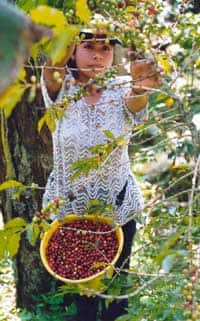 For the United States market, we transitioned the vanilla extract in our smooth Vanilla ice cream — and the cocoa powder in our smooth Chocolate ice cream — to Fair Trade Certified suppliers. In the European market, we added Chunky Monkey and Vanilla Toffee Crunch to our list of Fairtrade Certified flavours, made with Fairtrade banana puree, sugar, cocoa powder and vanilla. We’re proud to be a part of the growing Fair Trade movement that is helping small farmers in the developing world to earn a decent living, take care of their land, and send their children to school.
For the United States market, we transitioned the vanilla extract in our smooth Vanilla ice cream — and the cocoa powder in our smooth Chocolate ice cream — to Fair Trade Certified suppliers. In the European market, we added Chunky Monkey and Vanilla Toffee Crunch to our list of Fairtrade Certified flavours, made with Fairtrade banana puree, sugar, cocoa powder and vanilla. We’re proud to be a part of the growing Fair Trade movement that is helping small farmers in the developing world to earn a decent living, take care of their land, and send their children to school.
We began a four-year transition to Certified Humane Cage-Free suppliers for all of the eggs used in our U.S. ice cream production in 2007, fulfilling a promise we made a year ago. We believe this transition will make our egg supply the envy of the food industry — and make us the darling of ethical consumers and chickens everywhere. We’ll continue to use free-range eggs for 100% of our European production.
To keep up with our growing U.S. business, we opened a new Ben & Jerry’s production line in an existing Unilever ice cream facility in Henderson, Nevada, in June of 2007. We believe this decision makes sense from an environmental and economic standpoint, as it will help us keep down the carbon dioxide emissions — and costs — associated with transporting our products across a large continent. We also made sure to connect with family farmers who have pledged not to treat their cows with recombinant bovine growth hormone (rBGH) to supply the milk and cream for the ice cream we’re making out West. While it was a difficult decision for our Company to produce ice cream for the U.S. market outside of Vermont — given that our identity is so closely connected to our groovy, progressive, and green home state — we feel we’re going about this next phase in our growth in a responsible way that’s consistent with our values.
We did not reach one of our goals for 2007, which was to achieve Forest Stewardship Council (FSC) certification for our new pint container in the United States. FSC certification is a rigorous, third-party guarantee that wood and paper products are sourced from forests that are sustainably managed. This project was delayed several times over the course of 2007, but we remain committed to this goal and hope the transition to FSC certified paperboard will be completed in 2008. We’ll also be working to bring our European packaging up to a similar certification at the same time.
For the Environment…
In our ongoing quest to help the farmers who supply our dairy ingredients to pursue sustainable practices, 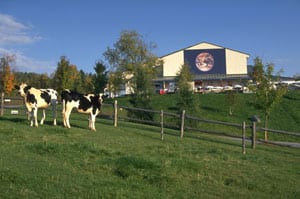 we took a giant leap forward in 2007. Our European Caring Dairy program started a partnership with a Dutch cooperative of over 500 dairy farmers. The CONO cooperative will be Ben & Jerry’s sole European supplier of milk and cream, while all farmers will use the Caring Dairy toolkit to drive continuous improvement towards sustainable practices. In the United States, we are also growing the Dairy Stewardship Alliance to include more Vermont farmers, and transforming our sustainable agriculture toolkit into an interactive online resource.
we took a giant leap forward in 2007. Our European Caring Dairy program started a partnership with a Dutch cooperative of over 500 dairy farmers. The CONO cooperative will be Ben & Jerry’s sole European supplier of milk and cream, while all farmers will use the Caring Dairy toolkit to drive continuous improvement towards sustainable practices. In the United States, we are also growing the Dairy Stewardship Alliance to include more Vermont farmers, and transforming our sustainable agriculture toolkit into an interactive online resource.
We worked hard in 2007 to reduce our climate impacts, investing in efficiency projects in our manufacturing plants, renewable energy, and carbon offsets. For the sixth year in a row, we offset all 5,140 tons of CO2 emissions that we created in our Vermont manufacturing operations through our partners at NativeEnergy. In Europe, as a part of our Climate Neutral Ice Cream initiative, we committed €2 million over five years to purchase high quality offsets for all of the emissions created in the process of making and selling Ben & Jerry’s ice cream in the European Union, from cow to cone. All of the offsets we purchase funded new renewable energy projects.
In the Community…
From Ben & Jerry’s headquarters, we devoted over $3.2 million in resources to hundreds of projects and groups that promote positive social and environmental change. 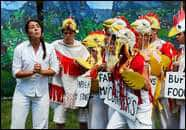 Starting with the Company’s contribution to the Ben & Jerry’s Foundation and extending to product donations, flavor royalties paid to nonprofit organizations, community service, and issue-based marketing, we put more money, ice cream, and employee time than ever towards living our values. Learn more about the ways we give back to the community.
Starting with the Company’s contribution to the Ben & Jerry’s Foundation and extending to product donations, flavor royalties paid to nonprofit organizations, community service, and issue-based marketing, we put more money, ice cream, and employee time than ever towards living our values. Learn more about the ways we give back to the community.
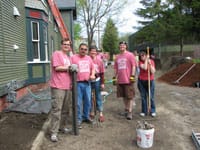 Around the world, Ben & Jerry’s Scoop Shop teams rolled up their sleeves and contributed over $500,000 in product donations, cash, and employee time to support local community projects. From relief efforts to blood drives to fundraisers, our franchisees are finding ways to make a positive impact in their own neighborhood.
Around the world, Ben & Jerry’s Scoop Shop teams rolled up their sleeves and contributed over $500,000 in product donations, cash, and employee time to support local community projects. From relief efforts to blood drives to fundraisers, our franchisees are finding ways to make a positive impact in their own neighborhood.
In its 29th year of Scoop Shop tradition, Ben & Jerry’s Free Cone Day served up some 1.3 million free scoops to ice cream lovers worldwide, extending thanks to our neighbors while helping 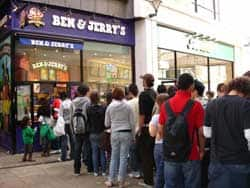 local nonprofit partners to spread the word about their mission. In all, the global event raised over $250,000 for hundreds of organizations in communities where Ben & Jerry’s franchisees are doing well by doing good.
local nonprofit partners to spread the word about their mission. In all, the global event raised over $250,000 for hundreds of organizations in communities where Ben & Jerry’s franchisees are doing well by doing good.
We had a great year of launching new ice cream flavors, and three of our latest concoctions have the added benefit of paying a royalty to a nonprofit organization. Stephen Colbert’s AmeriCONE Dream and Willie Nelson’s Country Peach Cobbler in the U.S. and Bohemian Raspberry in Europe all hit the sweet spot — and the jackpot — for causes ranging from Farm Aid to AIDS education. In all, Ben & Jerry’s royalty flavors paid over $600,000 to nonprofit organizations around the world in 2007.
The Ben & Jerry’s Foundation continued its high-impact grant-making to progressive organizations working to address the root causes of social and environmental problems in the United States. Our Company allocated $1,699,684 to the Foundation in 2007, a 7% increase, and the Foundation awarded grants totaling over $1,688,000 over the course of the year.
 Inspired by An Inconvenient Truth, Al Gore’s 2006 documentary film on global warming, Ben & Jerry’s kicked off an Environmental Community Action Contest open to every high school student in Vermont in 2007. Two students from Vermont Academy, Rachel and Savannah, took home the grand prize of $2,000 for their proposal to construct a wind turbine on their school campus and to educate their community about the potential of wind energy. To learn more about the project, watch the video Savannah and Rachel made for The Alliance for Climate Protection.
Inspired by An Inconvenient Truth, Al Gore’s 2006 documentary film on global warming, Ben & Jerry’s kicked off an Environmental Community Action Contest open to every high school student in Vermont in 2007. Two students from Vermont Academy, Rachel and Savannah, took home the grand prize of $2,000 for their proposal to construct a wind turbine on their school campus and to educate their community about the potential of wind energy. To learn more about the project, watch the video Savannah and Rachel made for The Alliance for Climate Protection.
In the Public Eye…
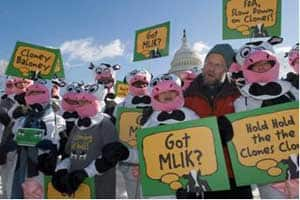 When the U.S. Food and Drug Administration declared in December, 2006 that it believed meat and milk from cloned animals was safe to eat, we were beside ourselves, twice over! So we took to the streets of Washington D.C. with more than 100 people in cow costumes to show our disappointment with the FDA’s decision — and to urge Americans to speak out against cloning during the FDA’s 90-day public comment period. Despite our efforts, on January 15, 2008, the FDA announced that it had determined foods from cloned animals and their progeny were safe for human consumption. We will continue to be engaged with Congress and the federal government on the cloning issue to protect consumers’ right to avoid cloned foods if they desire. And we will work with our suppliers to do our very best to keep cloned cows and their offspring out of our supply chain.
When the U.S. Food and Drug Administration declared in December, 2006 that it believed meat and milk from cloned animals was safe to eat, we were beside ourselves, twice over! So we took to the streets of Washington D.C. with more than 100 people in cow costumes to show our disappointment with the FDA’s decision — and to urge Americans to speak out against cloning during the FDA’s 90-day public comment period. Despite our efforts, on January 15, 2008, the FDA announced that it had determined foods from cloned animals and their progeny were safe for human consumption. We will continue to be engaged with Congress and the federal government on the cloning issue to protect consumers’ right to avoid cloned foods if they desire. And we will work with our suppliers to do our very best to keep cloned cows and their offspring out of our supply chain.
In 2007, we sponsored a resolution and circulated it among U.S. businesses calling on the world community to use economic sanctions and diplomatic pressure to protect the people of Darfur. While it had nothing to do with ice cream, we believe that in a time of extraordinary humanitarian crisis, we all have a responsibility to speak up for justice.
OUR COMPANY
Ben & Jerry’s Homemade, Inc.
Ben & Jerry’s has been making the finest all natural ice cream since 1978 when grade school buddies Ben Cohen and Jerry Greenfield opened their first Scoop Shop in Burlington, Vermont. Though we’ve never strayed from the boys’ original dream — to create unique and euphoric ice cream flavors while making a positive impact along the way — we have grown and changed in all sorts of ways. Today, Ben & Jerry’s is owned by Unilever, and our packaged ice cream and novelties are sold in stores across the U.S. and in 27 other countries around the world. We also have over 700 Scoop Shops in operation around the globe.
Company Timeline
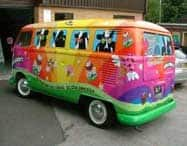 To learn more about the journey from our humble beginnings to where we are today, take a look at our Company timeline. We think you’ll agree that it’s been quite a wild ride.
To learn more about the journey from our humble beginnings to where we are today, take a look at our Company timeline. We think you’ll agree that it’s been quite a wild ride.
Company Profile
Check out the latest on the scope of our business.
Ben & Jerry’s Mission
We’re still a Company on a mission! Read our three-part Mission Statement that has inspired our Company since 1988, along with other guiding statements.
Governance
As a wholly-owned subsidiary of Unilever, we are governed by North American Ice Cream in Green Bay, Wisconsin, as well as an outside Board of Directors.
In a Nutshell...
Ben & Jerry’s Homemade, Inc., a wholly-owned subsidiary of Unilever, is a Vermont-based corporation which manufactures and markets super premium ice cream, frozen yogurt, ice cream novelties and sorbet. Our products are produced in pints, quarts, 500 ml cups, 2.4-gallon tubs, single-serve cups and individual novelties. Ben & Jerry’s products are distributed in 28 countries around the world in supermarkets, grocery stores, convenience stores, Scoop Shops, restaurants and other venues.
Outside of North America, Ben & Jerry’s products are marketed and distributed by affiliated companies within Unilever and, in Israel, by a third party licensee.
Operations
Ben & Jerry’s ice cream for the North American market is made in our manufacturing plants in Waterbury and St. Albans, Vermont and, beginning in 2007, in a Unilever facility in Henderson, Nevada. We also make Ben & Jerry’s ice cream for the European market in a Unilever facility in Hellendoorn, the Netherlands and for the Canadian market in a Unilever facility in Simcoe, Ontario. Our frozen novelties are manufactured at Unilever facilities in Sikeston, Missouri; Hagerstown, Maryland; and by Rhino Foods in South Burlington, Vermont.
At the end of 2007, Ben & Jerry’s employed 508 people in the United States as compared to 514 in 2006. Our European manufacturing plant employs 100 people and an additional 63 Unilever employees across the globe work on sales, marketing, and related functions for the Ben & Jerry’s brand.
Yearly Revenue
As a wholly-owned subsidiary of Unilever, Ben & Jerry’s is part of a larger multinational publicly-traded business. For the purpose of this report, the Company reports financial results based on an annual revenue reporting range provided by the Global Reporting Initiative (GRI). For 2007, Ben & Jerry’s revenue was between $200 million and $500 million.
Our Three Part Mission Statement
We have a statement of mission nearly as old as our brand. When people ask, as they often do, how we make our daily decisions and what we mean by “values-led business,” we point to our Mission Statement, the glue that holds things together — campaigns and causes, employee benefits, best practices and business decisions, platforms, position statements and projects of every kind.
Here’s how it reads:

If you would like to read our Mission Statement in depth you can find it here as well.
Of course, the Mission Statement only comes to life through the committed efforts of employees. Each of us within the Company is accountable for developing products, processes and programs that fit within the framework of this mission and that uphold our Company values. In addition, every employee, every year, commits to at least one personal Social Mission target as a part of his or her Professional Development Plan.
Since the year 2000, it’s been reasonable to ask how Ben & Jerry’s acquisition by Unilever has affected our ability to deliver on our Company’s Mission Statement, most specifically the Social Mission. While the mix of active projects and initiatives inspired by our Social Mission is often changing, our core values remain consistent. To cite a few examples, we remain committed to our partnership with the Vermont family farmers of the St. Albans Cooperative Creamery; to sourcing our milk and cream from cows not treated with recombinant growth hormone; to reducing our environmental impacts; to paying our employees a livable wage; and to using the power of our brand to draw attention to important issues like global climate change, global peace and justice, and the struggle of family farms.
At the same time, being a part of a larger, more complex organization has presented new challenges and opportunities related to our Social Mission. We have had some difficulty executing Social Mission initiatives that require close coordination with Unilever’s Supply Chain, such as the transition to Forest Stewardship Council certified paperboard for our pint containers. Some projects have been postponed or delayed because they were misaligned with Unilever’s annual planning framework. On the other hand, we have found strong support within Unilever for certain programs that address sustainability challenges, such as Caring Dairy and new investment in efficiency upgrades and carbon offsets for our European manufacturing.
Our ongoing commitment is to educate Ben & Jerry’s and Unilever employees about our Social Mission and to fully engage in an ongoing, healthy, and vigorous debate about how Ben & Jerry’s and Unilever can work together for shared success and for positive results on the triple-bottom-line of both companies.
Our corporate headquarters were busier than ever in 2007 as the Ben & Jerry’s business grew rapidly around the globe. Without significant new hiring, this expansion into new markets created heavy workloads in our Burlington office. In addition, the outsourcing of a variety of financial, computer support and human resource services continues to gently tax the time and energy of people within the company. In 2008, we anticipate new hiring in key areas will help us to regain a greater sense of balance in the office.
On the other hand, our Vermont manufacturing plants had more downtime in 2007, as the addition of new pint manufacturing capacity in the western U.S. impacted our supply chain. Slower sales of our sister brands also exacerbated this trend. The lower production volumes and increased downtime in our plants hurt morale but we were able to maintain operations without resorting to lay-offs.
We continued in our grass-roots efforts to activate the Social Mission throughout the organization in 2007. Two employee-led workgroups convened in 2007 and, after a period of research and discovery, provided valuable input on a range of issues for our Social Mission four-year plan. The top-level priorities we identified through this process were:
- Increasing ‘Values-Led’ sourcing
- Fighting climate change
- Pursuing Eco-packaging
- Promoting prosperity, peace & justice
Working with input from our global team, we are building specific targets and goals around each of these action areas that will inform our Social Mission activities going forward.
Other Guideposts
While our Mission Statement is the essential document that keeps us all pulling together in the same direction, we also look to two other documents to guide us as we strive to leverage the power of our business to create positive social and environmental impacts.
Our statement on progressive values expands on our Social Mission statement to articulate what we mean when we talk about improving the quality of life in the communities where we have a presence.
Leading with Progressive Values Across Our Business
We have a progressive, nonpartisan Social Mission that seeks to meet human needs and eliminate injustices in our local, national, and international communities by integrating these concerns into our day-to-day business activities. Our focus is on children and families, the environment and sustainable agriculture on family farms.
- Capitalism and the wealth it produces do not create opportunity for everyone equally. We recognize that the gap between the rich and the poor is wider than at any time since the 1920s. We strive to create economic opportunities for those who have been denied them and to advance new models of economic justice that are sustainable and replicable.
- By definition, the manufacturing of products creates waste. We strive to minimize our negative impact on the environment.
- The growing of food is overly reliant on the use of toxic chemicals and other methods that are unsustainable. We support sustainable and safe methods of food production that reduce environmental degradation, maintain the productivity of the land over time, and support the economic viability of family farms and rural communities.
- We seek and support nonviolent ways to achieve peace and justice. We believe government resources are more productively used in meeting human needs than in building and maintaining weapons systems.
- We strive to show a deep respect for human beings inside and outside our company and for the communities in which they live.
CERES Principles
In 1992, Ben & Jerry’s signed the CERES Principles to acknowledge our responsibility for the environment. The ten aspirational principles guide us in all aspects of our business as responsible stewards of the environment by operating in a manner that protects the earth.
Protection of the Biosphere
We will reduce and make continual progress toward eliminating the release of any substance that may cause environmental damage to the air, water, or the earth or its inhabitants. We will safeguard all habitats affected by our operations and will protect open spaces and wilderness, while preserving biodiversity.
Sustainable Use of Natural Resources
We will make sustainable use of renewable natural resources, such as water, soils and forests. We will conserve nonrenewable natural resources through efficient use and careful planning.
Reduction and Disposal of Wastes
We will reduce and where possible eliminate waste through source reduction and recycling. All waste will be handled and disposed of through safe and responsible methods.
Energy Conservation
We will conserve energy and improve the energy efficiency of our internal operations and of the goods and services we sell. We will make every effort to use environmentally safe and sustainable energy sources.
Risk Reduction
We will strive to minimize the environmental, health and safety risks to our employees and the communities in which we operate through safe technologies, facilities and operating procedures, and by being prepared for emergencies.
Safe Products and Services
We will reduce and where possible eliminate the use, manufacture or sale of products and services that cause environmental damage or health or safety hazards. We will inform our customers of the environmental impacts of our products or services and try to correct unsafe use.
Environmental Restoration
We will promptly and responsibly correct conditions we have caused that endanger health, safety or the environment. To the extent feasible, we will redress injuries we have caused to persons or damage we have caused to the environment and will restore the environment.
Informing the Public
We will inform in a timely manner everyone who may be affected by conditions caused by our company that might endanger health, safety or the environment. We will regularly seek advice and counsel through dialogue with persons in communities near our facilities. We will not take any action against employees for reporting dangerous incidents or conditions to management or to appropriate authorities.
Management Commitment
We will implement these Principles and sustain a process that ensures that the Board of Directors and Chief Executive Officer are fully informed about pertinent environmental issues and are fully responsible for environmental policy. In selecting our Board of Directors, we will consider demonstrated environmental commitment as a factor.
Audits and Reports
We will conduct an annual self-evaluation of our progress in implementing these Principles. We will support the timely creation of generally accepted environmental audit procedures. We will annually complete the CERES Report, which will be made available to the public.
How We Work
Since its acquisition in 2000, Ben & Jerry’s has been a wholly-owned subsidiary of Unilever, the Anglo-Dutch multinational food, home, and personal care products Company. Within Unilever, we are grouped with Good Humor, Breyers, Klondike, and Popsicle in North American Ice Cream (NAIC), based in Green Bay, Wisconsin.
Unilever announced in the fall of 2007 that it would close the Green Bay office and reconfigure its North American Ice Cream business, with new leadership for this division operating out of the Unilever headquarters in Englewood Cliffs, New Jersey beginning in 2008. Ben & Jerry’s will continue to be managed in Burlington, Vermont.
We anticipate that the closing of the NAIC headquarters in Green Bay will affect some reporting relationships and functions within Unilever that impact Ben & Jerry’s. For example, Ben & Jerry’s Sales, Supply Chain, Operations, Finance, Information Systems, and Distribution functions have been directed by NAIC for the last seven years, although some of these employees remained with us in Burlington, Vermont. These functions will be transitioned to Englewood Cliffs over the next twelve months. As we adjust to this significant organizational change, we are optimistic that it will simplify some reporting lines and open up new opportunities in the Social Mission arena.
With respect to our manufacturing plants, the leadership teams in our St. Albans and Waterbury, Vermont plants continue to integrate Ben & Jerry’s three-part Mission Statement into business decisions and workplace practices. All Vermont plant employees remain Ben & Jerry’s employees and continue to be entitled to unique Ben & Jerry’s benefits, such as the Livable Wage.
The folks who make Ben & Jerry’s ice cream in Unilever’s Henderson, Nevada plant remain Unilever employees who report through North American Ice Cream. They are covered by Unilever benefits and compensation policies.
Our Leadership Team
Here in Vermont, our Company is led by our Chief Euphoria Officer and General Manager, Walt Freese, who spearheads our senior leadership team, known collectively as the MOM (Managers of the Mission). Walt’s role includes oversight of Marketing, Research & Development, International, Retail Operations, Social Mission and Human Resources. He is also responsible for the Company’s P&L and the activation of our three-part Mission Statement. Walt represents Ben & Jerry’s on the NAIC Executive Committee. He is also a Vice President of the Global Ice Cream Category, responsible for Ben & Jerry’s development as a global brand. In this role he represents Ben & Jerry’s as a member of Unilever’s Global Category Leadership Team.
In 2007, Ben & Jerry’s Director of Social Mission was elevated to the role of Global Director of Social Mission, still reporting to the Chief Euphoria Officer. The European Social Mission Manager reports to the Global Social Mission Director. The Manager of Natural Resources reports to the Global Social Mission Director.
Ben & Jerry’s growth outside the United States is guided by Unilever employees who are identified as Ben & Jerry’s Brand Champions. These local people help to build the brand and support our commitment to values-led business wherever we trade, through their business acumen, appreciation of their country’s culture and their commitment to social and environmental change.
Ben & Jerry’s Board of Directors
Our Chief Euphoria Officer Walt Freese receives feedback and counsel on the Company’s direction from an independent Board of Directors, established at the time of the Unilever acquisition. The Board is responsible for advising and supporting Ben & Jerry’s senior management in maintaining and strengthening the company’s three-part Mission Statement and protecting Ben & Jerry’s brand equity. Although not a governing body in the traditional sense, the Board has authority to prevent any action by Unilever or Ben & Jerry’s leadership that it sees as inconsistent with the essential integrity of the Ben & Jerry’s brand, or the Social Mission. This Board, which meets quarterly, includes several former directors of the Company with longstanding ties to the brand.
Once again in 2007, the Board played a significant role in advising Ben & Jerry’s senior management on a number of important decisions.
VALUES-LED SOURCING
Overview
Everyone knows it takes the finest ingredients to make great ice cream. But to make truly euphoric Ben & Jerry’s ice cream, we’re also looking for suppliers of those ingredients who are working to make the world a better place. We call this project “Values-Led Sourcing” and we’ve been working at it for most of our Company’s history. We believe that incorporating our Company values into our purchasing decisions is one of the best ways we can advance all three parts of our Company Mission together.
Some of the Values-Led Sourcing initiatives we’ve included in our purchasing decisions include suppliers with…
- Environmental commitments, such as carbon dioxide balancing from Superior Nut.
- Social vision, such as job training and community support from Greyston Bakery.
- Third party certifications, such as Fair Trade.
Going the extra mile for Values-Led Sourcing is not always an option. At times, we’re unable to find the quality we need, supplies aren’t up to our specifications, or costs exceed what we can sustainably afford.
In 2007, 39 percent of the raw material spend (i.e., ingredients, dairy, packaging) for our Vermont production went to initiatives that we see as aligned with our values, compared to 49 percent in 2006. Figures for production at other plants were not available at the time of this report’s publication. The significant drop is due to the fact that the paperboard we purchase for our pint packaging was not sourced through a VLS supplier in 2007 as we were delayed in our transition from the unbleached EcoPint, which was discontinued in 2006, to a pint made with Forest Stewardship Council Certified (FSC) paperboard. The FSC paperboard will be a VLS project, so we anticipate that our VLS spend percentage will rebound once we complete this packaging transition.
Our VLS spend percentage can be somewhat variable from year to year, rising and falling with the volatile price of milk. Excluding dairy and packaging purchases, however, our VLS spend percentage rose in 2007 for the first time in several years. This occurred because we began to phase in Certified Humane cage-free eggs in 2007, the first part of a four-year commitment.
We continue to work on new metrics to gauge the success and impact of our Values-Led Sourcing initiatives. We haven’t completed the work we began on this in 2006, in part because of the additional challenges to extend our analysis to our global supply chain, and the difficulty of the creating flexible and meaningful metrics. We still believe that these metrics will be a valuable tool as we make decisions about VLS going forward.
We also continue to seek a balance between our mission-driven desire to support forward-thinking suppliers and our need to keep costs down in our supply chain. When we find solutions that satisfy both goals, we know we’re on the right track.
In 2007, rising commodity prices around the world presented a big challenge in this regard, and we may see more of the same ahead in 2008. In any case, we expect our overall VLS spending to increase slightly as we maintain our current initiatives and continue to phase in Certified Humane Cage-Free Eggs between now and 2010. We do not have any major new values-led sourcing initiatives in the pipeline for 2008.
Outside of our Values-Led Sourcing initiatives, all of the suppliers for Ben & Jerry’s ice cream are expected to follow practices consistent with the Code of Business Principles of our parent company, Unilever. This code includes: continuous improvement in managing environmental impacts, safe and healthy standards for workers, and a firm commitment to human rights, among other things. Unilever is also a signatory to the UN Secretary General’s Global Compact of 1999 which commits the company to support and respect human rights within our sphere of influence.
New VLS Initiatives for 2007!
Western U.S. Production Gets rBGH-free milk and cream
When we opened a new Ben & Jerry’s production line in an existing Unilever ice cream facility in Henderson, Nevada, in June of 2007, we made sure to connect with family farmers who could pledge to supply us with milk and cream from cows not treated with recombinant bovine growth hormone (rBGH).
More Fair Trade Sourcing
In 2007, we expanded our purchasing of Fair Trade certified ingredients in our global supply chain. For the United States market, we transitioned the vanilla extract in our smooth Vanilla ice cream — and the cocoa powder in our smooth Chocolate ice cream — to Fair Trade Certified suppliers. In the European market, we added Chunky Monkey (with Fairtrade banana puree, sugar, and cocoa powder) and Vanilla Toffee Crunch (with Fairtrade vanilla, sugar, and cocoa powder) to our list of Fairtrade certified flavours.
Transition to Cage-Free Eggs in U.S.
We began a four-year transition to Certified Humane Cage-Free suppliers for all of the eggs used in our U.S. ice cream production in 2007. We’ll continue to use free-range eggs for 100% of our European production.
Milk & Cream
It Starts with the Cows
Ben & Jerry’s is committed to purchasing milk and cream for our ice cream and frozen yogurt from family farmers who pledge not to treat their cows with recombinant bovine growth hormone (rBGH), a genetically engineered hormone used to increase milk production.
U. S. — Vermont
For most of our company’s history, the St. Albans Cooperative Creamery in Vermont, made up of over 500 family farms, has been our partner and 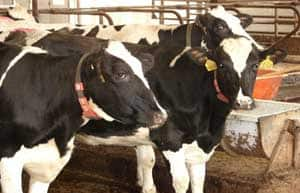 primary supplier of cream and condensed milk ingredients. The Coop is a member-owned business whose farmers have direct influence over their operations and their profit allocations.
primary supplier of cream and condensed milk ingredients. The Coop is a member-owned business whose farmers have direct influence over their operations and their profit allocations.
Over two decades, we’ve helped to provide a market for Vermont’s dairy farmers with our milk and cream purchases from the Coop. At the same time, the family farmers in the St. Albans Coop have played a big role in preserving Vermont’s rural heritage and in upholding many of the values we believe in.
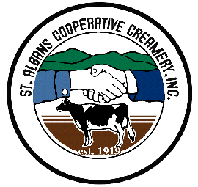 Ben & Jerry’s pays a premium to the farmers of the St. Albans Coop for their pledge not to treat the cows that produce our milk and cream with rBGH. We oppose the use of rBGH because we believe it is a step in the wrong direction toward a synthetic, chemically-intensive, factory-produced food supply.
Ben & Jerry’s pays a premium to the farmers of the St. Albans Coop for their pledge not to treat the cows that produce our milk and cream with rBGH. We oppose the use of rBGH because we believe it is a step in the wrong direction toward a synthetic, chemically-intensive, factory-produced food supply.
The St. Albans Coop is our partner in the Dairy Stewardship Alliance, a unique program that helps farmers move toward more sustainable practices on the farm.
U. S. — Outside of Vermont
In June of 2007, we opened a new Ben & Jerry’s pint production line in an existing Unilever ice cream facility in Henderson, Nevada. We source milk and cream for this facility from family farmers who pledge not to treat their cows with rBGH, through a dairy supplier based in nearby Las Vegas.
Ben & Jerry’s novelties, including The Cone and The Bar, are made in several different facilities around the country, but always using milk and cream from cows not treated with rBGH.
Europe — The Netherlands
We buy milk and cream for our European production from Dutch family farmers in the CONO Cooperative. All of these dairy ingredients are supplied without the use of recombinant Bovine Growth Hormone (rBGH) because this hormone is not approved in Europe. The CONO Cooperative is also our partner in the Caring Dairy initiative initiative, which seeks to promote continuous improvement in a wide range of sustainable dairy practices.
Canada — Ontario
The dairy ingredients used in our Canadian manufacturing are produced without the use of rBGH, as this hormone was not approved by the Canadian government.
Novelties
Ben & Jerry’s novelties are made in several different facilities around the country, but always using milk and cream from cows not treated with rBGH.
Fair Trade Certified Coffee Extract
 All of the coffee extract we use in our coffee flavors is Fair Trade Certified (Coffee, Coffee Heath Bar Crunch, Coffee Coffee Buzz Buzz Buzz). The Fair Trade certification logo on our coffee ice cream pints is a guarantee that the farmers who grow our coffee at Huatusco Cooperative,
All of the coffee extract we use in our coffee flavors is Fair Trade Certified (Coffee, Coffee Heath Bar Crunch, Coffee Coffee Buzz Buzz Buzz). The Fair Trade certification logo on our coffee ice cream pints is a guarantee that the farmers who grow our coffee at Huatusco Cooperative, 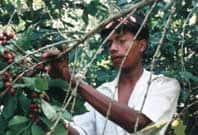 in Veracruz, Mexico are paid a fair price for their harvest; are members of democratically organized cooperatives; and have access to affordable credit. Fair Trade can help farmers earn the means to stay on their land, put food on their table, and keep their children in school. And Fair Trade certification signifies responsible stewardship of the land through environmentally sound farming techniques.
in Veracruz, Mexico are paid a fair price for their harvest; are members of democratically organized cooperatives; and have access to affordable credit. Fair Trade can help farmers earn the means to stay on their land, put food on their table, and keep their children in school. And Fair Trade certification signifies responsible stewardship of the land through environmentally sound farming techniques.
Ben & Jerry’s is glad to be a part of the growing Fair Trade movement around the world, which allows socially conscious consumers to have a positive impact on people and communities in the developing world. To learn more about Fair Trade, visit Transfair USA.
Greyston Bakery Brownies
The brownies in our Chocolate Fudge Brownie and Half Baked  ice creams and frozen yogurts come from the Greyston Bakery in Yonkers, NY, our partner since 1988. The bakery is owned by the Greyston Foundation, a nonprofit with a mission to support low-income people and families on the path to self-sufficiency. The foundation manages several businesses and programs
ice creams and frozen yogurts come from the Greyston Bakery in Yonkers, NY, our partner since 1988. The bakery is owned by the Greyston Foundation, a nonprofit with a mission to support low-income people and families on the path to self-sufficiency. The foundation manages several businesses and programs 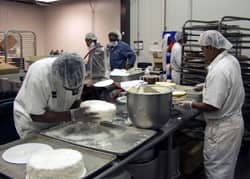 in the Yonkers area that provide housing for the homeless, childcare, employment training, jobs, and comprehensive healthcare for people living with HIV/AIDS. Over 2,000 people are reached by Greyston programs each year.
in the Yonkers area that provide housing for the homeless, childcare, employment training, jobs, and comprehensive healthcare for people living with HIV/AIDS. Over 2,000 people are reached by Greyston programs each year.
From the start, we’ve paid a premium for Greyston’s great brownies to help the bakery establish itself and to support the implementation of its mission. Along the way, we’ve worked together 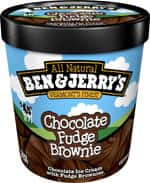 to reduce this premium as Greyston evolves into a viable, competitive and sustainable business.
to reduce this premium as Greyston evolves into a viable, competitive and sustainable business.
As we’ve grown globally, we’ve brought this relationship along too, so that the brownies we use to produce these flavors everywhere in the world come from Greyston Bakery and support their mission of economic revitalization and personal empowerment.
Fair Trade Vanilla
 Ben & Jerry’s Smooth Vanilla ice cream produced for the U.S. market is now made with Fair Trade Certified vanilla extract, catching up with our European Vanilla, which earned Fairtrade certification in 2006. This means that the farmers in India, Indonesia, Uganda, and elsewhere who grow this vanilla are paid a fair price for their harvest; are members of democratically organized cooperatives; and are pursuing continuous improvement in sustainable farming practices. With increased incomes and the more stable prices that Fair Trade/Fairtrade supports, vanilla growers are able to stay on their land, support their families, and improve their communities.
Ben & Jerry’s Smooth Vanilla ice cream produced for the U.S. market is now made with Fair Trade Certified vanilla extract, catching up with our European Vanilla, which earned Fairtrade certification in 2006. This means that the farmers in India, Indonesia, Uganda, and elsewhere who grow this vanilla are paid a fair price for their harvest; are members of democratically organized cooperatives; and are pursuing continuous improvement in sustainable farming practices. With increased incomes and the more stable prices that Fair Trade/Fairtrade supports, vanilla growers are able to stay on their land, support their families, and improve their communities.
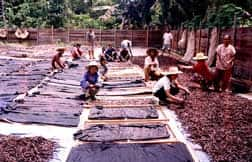 Ben & Jerry’s is pleased to have been a catalyst for the extension of Fair Trade Certification to vanilla and we’re excited that we are one of the first companies in the world using a significant volume of Fair Trade vanilla in our products.
Ben & Jerry’s is pleased to have been a catalyst for the extension of Fair Trade Certification to vanilla and we’re excited that we are one of the first companies in the world using a significant volume of Fair Trade vanilla in our products.
In the bigger picture, we are a strong supporter of the growing Fair Trade movement, which allows socially conscious consumers to have a positive impact on people and communities in the developing world.
Ben & Jerry’s is pleased to have been a catalyst for the extension of Fair Trade Certification to vanilla and we’re excited that we are one of the first companies in the world purchasing vanilla on Fair Trade terms.
 In the bigger picture, we’re proud to be a part of the growing Fair Trade movement, which allows socially conscious consumers to have a positive impact on people and communities in the developing world.
In the bigger picture, we’re proud to be a part of the growing Fair Trade movement, which allows socially conscious consumers to have a positive impact on people and communities in the developing world.
To learn more about Fair Trade in the U.S., visit our friends at Transfair USA; to learn more about Fairtrade in Europe, visit our friends at Max Havelaar.
Fair Trade Cocoa Powder
Ben & Jerry’s Smooth Chocolate ice cream produced for the U.S. market is now made with Fair Trade Certified cocoa powder. And the cocoa powder used in the chunks and coatings for our European flavors Chunky Monkey and Vanilla Toffee Crunch is Fairtrade Certified, too.
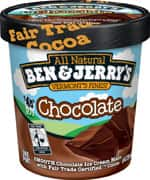
This means that the farmers in the Dominican Republic and West Africa who produce this cocoa are paid a fair price for their harvest; avoid child labor; are members of democratically organized cooperatives; and are pursuing continuous improvement in sustainable farming practices. With increased incomes and the more stable prices that Fair Trade/Fairtrade supports, these growers are able to stay on their land, support their families, and improve their communities.
Ben & Jerry’s supports these improvements in farmers’ lives by paying a premium for Fair Trade / Fairtrade Certified cocoa powder.
Since 2002, when we unveiled the flavor “Chocolate for a Change,” we’ve made a special effort to source some of the cocoa powder we use from cooperatives of small-scale farmers who are committed to progressive practices. 2007 is the first year that we have purchased cocoa that carries the Fair Trade/Fairtrade certification.
With this choice, we’re aligning more of our sourcing with the growing Fair Trade movement, which allows socially conscious consumers to have a positive impact on people and communities in the developing world.
To learn more about Fair Trade in the U.S., visit our friends at Transfair USA; to learn more about Fairtrade in Europe, visit our friends at Max Havelaar.
Peanut Butter
Superior Peanut Butter
Superior Nut, a small, family-owned enterprise, produces the peanut butter products we use in flavors such as Chocolate Peanut Butter Swirl. As a 100% carbon neutral business, Superior Nut offsets all of the carbon dioxide (CO2) emissions associated with their U.S. processing plant and vehicle travel.
Since 1997, Superior Nut has managed its offsets through a unique partnership with the nonprofit organization, Reforest the Tropics, which supports reforestation efforts in Costa Rica. As the major supporter of RTT, Superior Nut has sponsored the planting of over 50 acres of carbon-offset forests to date. These forests also provide income to the Costa Rican farmers who harvest selected trees as a necessary part of sustainable forest management.
We’re happy to support this innovative work that addresses the challenge of global warming and supports reforestation efforts through our purchases of peanut products from Superior Nut.
Strawberries
Ben & Jerry’s Strawberry ice cream in the United States is made with puree from a blend of  strawberries grown on two farms that are leading the way towards environmentally sustainable agricultural practices.
strawberries grown on two farms that are leading the way towards environmentally sustainable agricultural practices.
Stahlbush Island Farms in Corvallis, Oregon is working to protect their groundwater and farmlands through the use of sustainable farming techniques, including integrated pest management, farm nutrient management, and wildlife conservation initiatives.
Mike & Jean’s Berry Farm in Skagit County, Washington also has a great track record of sustainable practices and a strong commitment to progressive labor practices, providing their seasonal workers with housing, daycare, and space for kitchen gardens.
We buy our strawberries from these farms to support their staunch commitment to better environmental and social practices. In 2007, we produced this flavor only for our Scoop Shops.
Cage Free Eggs
In 2007, we continued to transition our egg purchases to suppliers who use cage-free production systems. We believe that cage-free production is more in line with our commitment to animal welfare than conventional cage production, so we’re moving as quickly as we can to make the change to suppliers who use cage-free / free-range production systems.
All of the eggs we source for our European production are ‘free-range’ eggs (‘vrije uitloop’), which we’ve been doing since 2004. We pay a significant premium for these eggs above the cost of more conventionally produced ‘barn’ eggs or ‘battery cage’ eggs.
In the United States, we are in the process of phasing in Certified Humane cage-free eggs over four years. We began the transition in 2007, so by the end of 2010, we’ll have all of our eggs for U.S. production coming from cage-free hens. The phase-in period was necessary to allow Ben & Jerry’s to absorb the additional cost of Certified Humane cage-free eggs and to give the cage-free industry time to expand supply to meet our volume requirements.
The Certified Humane designation for our U.S. egg supply means that, in addition to being housed in cage-free systems, egg-laying hens are guaranteed to have wholesome, nutritious food, access to clean water, and adequate space to engage in normal behaviors, among dozens of criteria crafted by veterinary professionals. Compliance with these standards is provided by the nonprofit organization Humane Farm Animal Care in Herndon, Virginia.
Fairtrade Bananas
Ben & Jerry’s Chunky Monkey ice cream produced for the European market is now made with Fairtrade Certified bananas, an exciting Values-Led Sourcing initiative we rolled out at the end of 2007. The Fairtrade logo on the pint means that the farmers in Ecuador who grew these bananas were paid a fair price for their harvest; 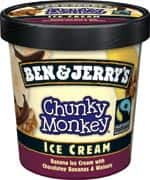 are members of democratically organized cooperatives; and are pursuing continuous improvement in sustainable farming practices. With increased incomes and the more stable prices that the Fairtrade market supports, banana growers are better able to stay on their land, support their families, and improve their communities.
are members of democratically organized cooperatives; and are pursuing continuous improvement in sustainable farming practices. With increased incomes and the more stable prices that the Fairtrade market supports, banana growers are better able to stay on their land, support their families, and improve their communities.
In the bigger picture, we are a strong supporter of the growing Fairtrade movement, which allows socially conscious consumers to have a positive impact on people and communities in the developing world.
To learn more about Fair Trade in the U.S., visit our friends at Transfair USA; to learn more about Fairtrade in Europe, visit our friends at Max Havelaar.
Fairtrade Sugar
As it says right on the pint, Ben & Jerry’s Fairtrade flavors produced for the European market are made entirely with Fairtrade Certified sugar. In 2007, these flavors included Vanilla Toffee Crunch, Chunky Monkey, and Smooth Vanilla, and we plan to grow the list in the years to come.
Fairtrade certification means that the sugarcane farmers in Paraguay who produced the sugar used in these flavors were paid a fair price for their harvest; are members of democratically organized cooperatives; and are pursuing continuous improvement in sustainable farming practices. With increased incomes and the more stable prices that Fairtrade certification supports, these sugarcane growers are better able to stay on their land, support their families, and improve their communities.
In the bigger picture, we are a strong supporter of the growing Fairtrade movement, which allows socially conscious consumers to have a positive impact on people and communities in the developing world.
To learn more about Fair Trade in the U.S., visit our friends at Transfair USA; to learn more about Fairtrade in Europe, visit our friends at Max Havelaar.
Blueberries
Ben & Jerry’s Berried Treasure sorbet in the United States is made with blueberry puree that comes from Wyman’s, a family-owned Maine business.
Wyman’s is a member of the Sustainable Food Lab, a leading-edge industry group pursuing sustainable solutions in the food industry. Wyman’s has a long track record of using environmentally leading practices including integrated pest management, composting of organic wastes, and careful management of water and land resources. They also have progressive policies that ensure fair compensation and safe working conditions for the field laborers they employ.
SCOOP SHOPS
Bringing Ice Cream to the People
 Ben & Jerry’s began as a single ice cream scoop shop in 1978, and though our business has taken plenty of twists, turns, and swirls along the way, we’re in the scoop shop business more than ever before. Most are owned and operated by independent franchisees, although Ben & Jerry’s also manages a small number of company-owned stores; and 11 of our stores are PartnerShops, owned and operated by nonprofit organizations.
Ben & Jerry’s began as a single ice cream scoop shop in 1978, and though our business has taken plenty of twists, turns, and swirls along the way, we’re in the scoop shop business more than ever before. Most are owned and operated by independent franchisees, although Ben & Jerry’s also manages a small number of company-owned stores; and 11 of our stores are PartnerShops, owned and operated by nonprofit organizations.
Here’s a quick summary of where you could find our scoop shops around the globe at the end of 2007:
United States and Canada
- 454 franchised scoop shops
- 9 PartnerShops
- 10 company-owned stores (Vermont, New York City & Las Vegas)
Europe (12 countries)
- 280 franchised scoop shops
- 2 PartnerShops
- 3 company-owned stores (UK)
Asia (Hong Kong, Singapore, Turkey)
- 18 scoop shops
Latin America (Mexico)
- 15 scoop shops
Visit Ben & Jerry’s scoop shops page on our company website for more information.
Serving Ice Cream to Serve Humanity
In addition to being gathering places for great ice cream, scoop shops aim to be centers for Social Mission and activism. So when we take stock every year of how well we in Vermont delivered on our Company values, we also extend our thanks to the dedicated scoop shop owners around the world who’ve brought a commitment to social and environmental change into the way they manage business in their communities.
As a Company, we continue to look for ways to activate the company’s Social Mission priorities in our scoop shop network. Here are some of the ways we’re acting on this idea:
Encourage business to give back to the community
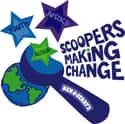 Our franchisees, their scoopers, and folks in our company-owned stores around the world made a difference by fostering positive social change through their local community action efforts in 2007.
Our franchisees, their scoopers, and folks in our company-owned stores around the world made a difference by fostering positive social change through their local community action efforts in 2007.
Through Scoopers Making Change, a grant program for Ben & Jerry’s scoop shop employees, we encourage greater activism through our business. In 2007 we offered grants to four scoop shop employees to support their plans to improve their communities.
As always, we celebrated the anniversary of Ben & Jerry’s 1978 debut with Free Cone Day. This year’s worldwide event was our biggest yet, and we helped raise money for hundreds of partner nonprofits around the globe at the same time.
Help youth build better futures
Our scoop shops are great venues to provide youth  who may face barriers to employment a place and a chance to gain critical job and life skills. That’s why we invented the PartnerShop model years ago, in which a Ben & Jerry’s scoop shop is owned and operated by a youth-focused nonprofit organization.
who may face barriers to employment a place and a chance to gain critical job and life skills. That’s why we invented the PartnerShop model years ago, in which a Ben & Jerry’s scoop shop is owned and operated by a youth-focused nonprofit organization.
 We continued Cones to Careers in 2007, a program that provides youth with job skills and hands-on work experience through internships in our company operated stores in New York and Vermont.
We continued Cones to Careers in 2007, a program that provides youth with job skills and hands-on work experience through internships in our company operated stores in New York and Vermont.
Build sustainable & inclusive business practices
We strive to build an inclusive and diverse franchise community. We track our progress in this arena annually and are always looking to improve our practices.
We also keep an eye on making our scoop shops as green as possible. We continue to look for opportunities to source and specify materials and items that meet national standards for building green — while also meeting our build-out cost targets and the demands of the food service industry. Current materials successfully accomplishing this goal include “green” flooring, solid-surface counters, lighting, refrigerants, and paint. In 2007 we increased the usage of energy-efficient lights in our scoop shops, but held off on making any other changes, largely because of substantial changes we expect to make to our scoop shop design in 2008.
We held the course with our conservative approach to opening new scoop shops in 2007. We continued to set high standards for franchisee candidates and made even more improvements to ensure that our Discovery Process is thorough and transparent. In this highly competitive marketplace, it is more important than ever for every prospective franchisee to have a clear understanding of the potential rewards and challenges of operating a Ben & Jerry’s scoop shop — so we set each other up for success.
2007 In Review: A Semi-Sweet Year
In 2007, we continued to see strong competition in the marketplace while at the same time, a weakening economy took its toll on the Quick Service Restaurant (QSR) industry. Our scoop shops were not immune to these less-than-ideal economic conditions. To help ease the stress on our franchisees, we made the decision not to raise the prices we charge to scoop shops for ice cream, despite rising input costs for many of our raw materials.
Not all news on the economic front was terrible. Despite tough conditions in the marketplace, we did see growth in our frozen beverage program, improved satisfaction among families and a modest increase in average sale per transaction. Also, for the first time in five years, we saw a small but positive sales trend across our system. We recognize that these are modest achievements, and remain committed to improving economic outcomes for our franchisees.
We spent much of 2007 putting in place strategies and programs to overcome the communications, distribution, and other challenges we faced in 2006.
Communications
Late in 2007, we were reminded that despite our good intentions, hard work and modest gains, not all franchisees were feeling so great about Ben & Jerry’s. Newsweek published an article in the U.S. airing the complaints of several disgruntled franchisees who claim they were treated unfairly by Ben & Jerry’s. We don’t believe the article presented an accurate or balanced story, but we’ve taken the criticism to heart and continue to work with our Franchise Advisory Committee (FAC) and franchisees to address their reasonable concerns. The positive outcome of this not-so-positive news story was that it spurred many operators to share their opinions and ideas for how we can improve outcomes in our franchise community.
Improving system-wide communications was a top priority for our Retail Team in 2007. We started by making a joint effort with franchisee leaders to move towards a more collaborative and respectful manner of working together. Together we laid out clear expectations for the tone of our business dialogue, and we have all benefited from a positive shift in recent months.
In February 2008 we launched the Rolling Cone, a new and improved web-based communications network for our franchise community. We think the Rolling Cone will play a huge role engaging more franchisees and managers, improving overall communications, and building better relationships all around.
Distribution
We had a generally smooth year in our supply chain in 2007. With new quality assurance processes in place, improved communication and coordination with our Unilever colleagues, and an overall better-trained organization, we have improved our forecasting and inventory planning. With these improvements, we did not experience any significant systemic shortages during 2007. We’re not perfect and occasional product shortages did occur, but we made an effort to communicate clearly with franchisees about these temporary shortages.
MICROS
We continued to work to address the shortcomings of our Scoop shops’ computerized cash register system, known as MICROS. With the technical expertise on staff, we were able to make some progress in the last half of 2007. We are currently evaluating a lower cost, secure system and working to improve functionality. We know franchisees are discontent with the limitations and costs of the system and with the manner in which we rolled it out. We will continue to work to find better solutions in 2008 and beyond.
The PartnerShop Program
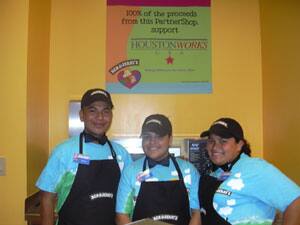 PartnerShops are Ben & Jerry’s Scoop Shops that are owned and operated by youth-serving nonprofit organizations. Ben & Jerry’s waives the traditional franchise and royalty fees for PartnerShops and provides customized training to support the unique needs of these social enterprises. In turn, PartnerShops offer youth facing barriers to employment a unique opportunity for developing job skills. All proceeds from PartnerShops flow back to
PartnerShops are Ben & Jerry’s Scoop Shops that are owned and operated by youth-serving nonprofit organizations. Ben & Jerry’s waives the traditional franchise and royalty fees for PartnerShops and provides customized training to support the unique needs of these social enterprises. In turn, PartnerShops offer youth facing barriers to employment a unique opportunity for developing job skills. All proceeds from PartnerShops flow back to  the parent nonprofit to support social programs.
the parent nonprofit to support social programs.
At the end of 2007, there were 11 PartnerShops in operation in the U.S., Northern Ireland and Scotland:
- Cresco Trust — Belfast, Northern Ireland
- Aberdeen Foyer — Aberdeen, Scotlands
- Friends of Youth — Seattle, WA
- <Goodwill Industries of Greater Detroit — Detroit, MI
- Juma Ventures — San Francisco and Oakland, CA
- Metro Community Investment — Minneapolis, MN
- Latin American Youth Center — Washington, DC
- Life’s Work of Western PA — Pittsburgh, PA
- Lifeworks — Austin, TX
- New Avenues for Youth — Portland, OR
- YWCA of Ft. Worth and Tarrant County — Ft. Worth, TX
After more than 20 years in the PartnerShop business, we remain committed to these social enterprises and the notion that business has the power to transform communities and help solve social problems. At the same time, we have seen enough PartnerShops open and close over the years to understand the various risks that accompany these ventures.
 Our most successful PartnerShops are those that have fully integrated the “PartnerShop Enterprise Director” role into their management structure. This person serves as the “franchisee” and is ultimately responsible for managing the financial, operational and job training outcomes for the PartnerShop. In 2007, shops with designated Enterprise Directors continued to show improved outcomes, and we’ll work hard in 2008 to extend this success.
Our most successful PartnerShops are those that have fully integrated the “PartnerShop Enterprise Director” role into their management structure. This person serves as the “franchisee” and is ultimately responsible for managing the financial, operational and job training outcomes for the PartnerShop. In 2007, shops with designated Enterprise Directors continued to show improved outcomes, and we’ll work hard in 2008 to extend this success.
Some stores have struggled to achieve their economic and social goals. Three PartnerShops closed in 2007, including the Cresco Trust shop in Derry, Northern Ireland, the Second Chance shop in San Diego, and the Latin American Youth Center’s shop in Chevy Chase, Maryland. While we’re always sad to see a PartnerShop close, we understand that sometimes it’s the best choice for our partners.
We continue to work to enhance the PartnerShop business model to allow our operators to be better positioned to meet their financial, operational and job training goals. We recognize that the model is especially challenging, given that PartnerShops aim to generate profits and to create positive social outcomes for the youth they serve at the same time.
Again in 2007, we stuck to our plan not to develop or pursue new relationships with nonprofits interested in opening PartnerShops. Instead, we will focus our efforts on supporting our current PartnerShop operators and explore new and innovative ways we can use our scoop shops to support community organizations.
Cones to Careers
Cones to Careers is a Ben & Jerry’s initiative that provides youth who face barriers to employment with job skills and hands-on work experience through internships in our company-operated Scoop Shops. We partner with nonprofit organizations to ensure that our interns have the pre-employment training they need and on-going support to achieve their goals.
We partner with nonprofit organizations to ensure that our interns have the pre-employment training they need and on-going support to achieve their goals.
Now in its fourth year, Cones to Careers is a fixture in our Burlington, Vermont company store, where we partner with Linking Learning to Life; and in our Times Square (New York) company store, where we work with youth development agency The Door. In 2007, 7 young people successfully completed the internship program in these two stores. All of these graduates were offered employment with Ben & Jerry’s after the program.
While we originally imagined Cones to Careers could have broader application throughout the franchise community, we have discovered that mentoring interns and managing a relationship with a nonprofit partner is a ton of work, likely too much for most franchisees to take on. For this reason we have not rolled out the program system-wide. Nevertheless, Cones to Careers provides our company stores with a great way to connect to and give back to the communities where we do business.
In 2008 we’ll continue to operate the program in Burlington’s Church Street scoop shop and at the Times Square location. In addition, we hope to expand the program in Burlington using Vermont Lake Monsters home baseball games as the venue for a new Cones to Careers partnership.
Scoopers Making Change
We launched Scoopers Making Change, a program aimed at helping young Ben & Jerry’s  scoop shop employees develop leadership and social activism skills in July 2006. Our first year of the program was a huge success, highlighted by a week-long program in which we brought nine young people to Company headquarters in Vermont to learn community organizing skills and to develop action plans for achieving social change in their communities. We sent each scooper home with a grant of up to $1,000 from Ben & Jerry’s to help with project implementation.
scoop shop employees develop leadership and social activism skills in July 2006. Our first year of the program was a huge success, highlighted by a week-long program in which we brought nine young people to Company headquarters in Vermont to learn community organizing skills and to develop action plans for achieving social change in their communities. We sent each scooper home with a grant of up to $1,000 from Ben & Jerry’s to help with project implementation.
Unfortunately, due to a lack of participation by franchisees, the Scoopers Making Change program only received five applications from scoopers in 2007. As a result, we were forced to scale back and modify the program, eliminating the training week in Vermont. We did provide four scoopers with training and up to $1,000 in grant funding to complete and execute their proposals in 2007.
Although we were disappointed to have to make these changes after such an uplifting pilot year, we’re proud of the scoop shop employees who submitted their ideas for making positive social change in their communities focused on gender identity awareness, bicycle education, single parent support, and recycling.
We certainly did not attain our goal of replicating the program and increasing participation, but we have no regrets about taking a chance and trying something new. As for Scoopers Making Change in 2008, the plan remains up in the air.
We’re grateful for the expertise and support of our friends from Youth Venture and the Vermont-based DREAM Program who have collaborated so closely with us and helped make Scoopers Making Change a pivotal experience for everyone involved. Our gratitude also goes out to the franchisees who sponsored the participants for our pilot program and in 2007.
Franchise Ownership Diversity
Our company’s statement of values includes the goal to create economic opportunities for those who have been denied them. We’ve always felt that our franchised Scoop Shops offer us a great opportunity to reach for this goal. While we do not have a formal program to recruit minorities and women to become Ben & Jerry’s franchisees, we have always attempted to create a culture in our franchise community where diversity is celebrated and encouraged.
We asked our franchisees about diversity in our annual system-wide survey in 2007 to gauge our progress. The relevant question asked: “Please rate how well you believe diversity is valued and respected in the Ben & Jerry’s franchise community.” 56% of respondents gave positive responses, with another 23% choosing a neutral score. 21% of respondents gave negative ratings, suggesting we can do a better job in this area.
The results dovetailed with a goal we set in 2006 to evaluate and update our franchise recruitment and discovery process to ensure we are reaching out to minorities and women.
We responded to the survey results and our own goal in 2007. Our franchise development team participated in a Diversity Awareness Training and worked closely with a diversity expert from the International Franchise Association to evaluate our franchisee recruitment and discovery processes. As a result of our work with the IFA, we made a few changes to our marketing materials and franchisee interview process, to make them more inclusive and welcoming to minorities and women. We feel comfortable with the changes we’ve made for now and plan to revisit the idea of creating programs to attract and welcome minorities and women next year.
For the record, here’s our track record on diversity: At the end of 2007, there were 200 distinct owner/operator groups for the 454 independently owned and operated Ben & Jerry’s shops in the United States and Canada. Of these owner/operator groups, we estimate 15% were led by women and another 20% were led jointly by a male/female team. Furthermore, approximately 19% of our total owner/operator groups were led by people of color (African-American, Asian, or Hispanic).
As for Ben & Jerry’s scoop shop leadership, our Franchise Advisory Council (FAC) is made up of 12 members, representing all four of our regions in the U.S. and Canada. Eight of these members are directly elected by franchisees and 3 are appointed by the Company. In 2007, one woman and no people of color served on the FAC.
We have never included language in our FAC by-laws regarding diversity, nor have we set goals to increase the representation of minorities and women on our FAC. Before FAC elections in 2009, we plan to take a closer look at the make-up of our franchise community and to evaluate how well the FAC represents the broader community.
Scoop Shop Community Action
Ben & Jerry’s franchisees take great pride in being part of their community, and virtually all translate our Social Mission into action in their own unique ways. We love to hear about projects far and near, and when we add up all the various community initiatives, including product donations and paid employee time, the sum total of our franchisees’ efforts always boggles our mind. In all, Ben & Jerry’s franchisees directly contributed almost $500,000 worth of time, product, and money in support of local community projects in 2007 — and leveraged even more support for valuable projects around the country through their efforts. We’re thankful for the dedication and creativity of our franchisees when it comes to community action.
Franchisee Highlights
The full story of our franchisees’ community activities in 2007 would crash your computer, so here are just a few tidbits that caught our attention:
Every year we honor one Ben & Jerry’s franchisee for extraordinary success in activating the Social Mission. In 2006, Mark Livingston, a franchisee who operates several stores in Missouri, won the honor. Mark puts his heart and soul into all that he does; he truly leads with his values and has mastered the art of giving back. In addition to dedicating thousands of hours to serving as a Big Brother through  Big Brothers Big Sisters, Mark is a volunteer with Habitat for Humanity’s St. Louis Chapter, a former board member for a local school district, and a current member of the board of a local nonprofit agency serving homeless youth. Mark has used his business to benefit children by making donations to 23 local schools — and dozens of nonprofits including the St. Louis Science Center, Saul Brodsky Jewish Community Center, the Palestinian Children’s Welfare Fund, St. Louis Children’s Hospital, the National Alliance For Autism Research, the National Leukemia and Lymphoma Society, the Cystic Fibrosis Foundation, and the American Cancer Society.
Big Brothers Big Sisters, Mark is a volunteer with Habitat for Humanity’s St. Louis Chapter, a former board member for a local school district, and a current member of the board of a local nonprofit agency serving homeless youth. Mark has used his business to benefit children by making donations to 23 local schools — and dozens of nonprofits including the St. Louis Science Center, Saul Brodsky Jewish Community Center, the Palestinian Children’s Welfare Fund, St. Louis Children’s Hospital, the National Alliance For Autism Research, the National Leukemia and Lymphoma Society, the Cystic Fibrosis Foundation, and the American Cancer Society.
Longtime franchisee Doug Barrese took over the Charlottesville, Virginia scoop shop in August of 2006 and he’s making a positive impact in many ways. Doug is an outstanding operator and a model ambassador for Ben & Jerry’s. He donates plenty of cakes and ice cream to nonprofits in his backyard, but he is most well-known in his community for two ongoing relationships. On one hand, he’s a huge supporter of the Virginia Institute for Autism. Each April, Doug donates a portion of proceeds from all frozen beverages to  the school, and on Free Cone Day 2008, Doug will try to collect 10,000 coins for their benefit. On the other hand, Doug has organized amazingly successful “Pint for a Pint” blood drives six times a year, in partnership with a local nonprofit agency. In 2007, donors at Doug’s Charlottesville shop gave more than 240 pints of blood. In addition, Doug isn’t afraid to think outside the box and explore new opportunities to use his business to support his community. For example, when a local Girl Scout troop asked to sell their cookies in Doug’s shop, he went even farther and purchased 60 boxes of Thin Mint cookies which he then worked into a featured menu item. In one week the Girl Scout promotion raised $250 for the troupe.
the school, and on Free Cone Day 2008, Doug will try to collect 10,000 coins for their benefit. On the other hand, Doug has organized amazingly successful “Pint for a Pint” blood drives six times a year, in partnership with a local nonprofit agency. In 2007, donors at Doug’s Charlottesville shop gave more than 240 pints of blood. In addition, Doug isn’t afraid to think outside the box and explore new opportunities to use his business to support his community. For example, when a local Girl Scout troop asked to sell their cookies in Doug’s shop, he went even farther and purchased 60 boxes of Thin Mint cookies which he then worked into a featured menu item. In one week the Girl Scout promotion raised $250 for the troupe.
Since taking over the Rancho Mirage scoop shop in Palm Springs in 2005, Laurie Kettering has worked endlessly to make it known that she cares about giving back to 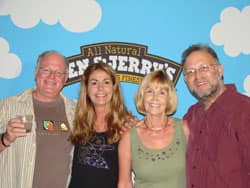 the community in which she lives and works. Laurie supports dozens of nonprofits, but programs serving children and animals are her personal favorites. For over 7 years Laurie has been a supporter of Guide Dogs of the Desert, an organization that matches blind people with Seeing Eye dogs. She supports this organization on Free Cone Day and throughout the year with donations of product and her time. Laurie is also a friend of The Living Desert Zoo and Gardens, a conservation organization and The Children’s Discovery Museum of the Desert which inspires and promotes intellectual curiosity and self expression. She hosts benefit nights and donates ice cream for these organizations several times a year.
the community in which she lives and works. Laurie supports dozens of nonprofits, but programs serving children and animals are her personal favorites. For over 7 years Laurie has been a supporter of Guide Dogs of the Desert, an organization that matches blind people with Seeing Eye dogs. She supports this organization on Free Cone Day and throughout the year with donations of product and her time. Laurie is also a friend of The Living Desert Zoo and Gardens, a conservation organization and The Children’s Discovery Museum of the Desert which inspires and promotes intellectual curiosity and self expression. She hosts benefit nights and donates ice cream for these organizations several times a year.
To learn more about the community activities of a Ben & Jerry’s franchisee near you, please use the local store locator on our Company website Scoop Shop page.
Annual Franchise Community Service Project
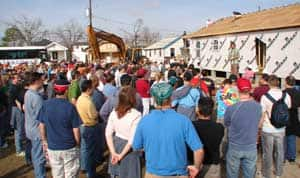 Once a year, Ben & Jerry’s franchisees get together at the Annual Franchise Community Gathering to network and share best practices. In true Ben & Jerry’s style, the meeting traditionally kicks off with a community service project in partnership with a local nonprofit organization in the host city. We’ve rebuilt houses, cleaned beaches, spruced up a community center, and built playgrounds and skate parks in underserved communities over the years.
Once a year, Ben & Jerry’s franchisees get together at the Annual Franchise Community Gathering to network and share best practices. In true Ben & Jerry’s style, the meeting traditionally kicks off with a community service project in partnership with a local nonprofit organization in the host city. We’ve rebuilt houses, cleaned beaches, spruced up a community center, and built playgrounds and skate parks in underserved communities over the years.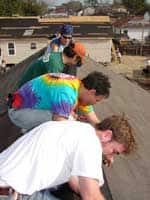
In 2007, staff, franchisees and managers from around the world gathered in post-Katrina New Orleans and got straight to work in Musician’s Village, building houses with our friends from The New Orleans Area Habitat for Humanity. We could have gathered in a host of sunny vacation spots, but chose to return to New Orleans (we gathered there in 2005). While we rarely return to the same city twice for this gathering, we felt coming back to the Crescent City was one small way we could support the people devastated by the storm. In short, we hoped that bringing our franchisees to New Orleans would play a small part in helping the city as it recovers from Hurricane Katrina. We brought our tourist dollars and, as always, we brought our hammers and nails, too. In two great days of work, Ben & Jerry’s donated 2,500 hours of labor to New Orleans Habitat for Humanity, in addition to $30,000 in cash support.
Company Store Community Involvement
Our company stores continue to model the spirit of giving back through their community involvement and donations programs. In 2007, ten company stores in New York, Las Vegas and Vermont contributed more than $36,500 worth of product and staff time in support of over 50 nonprofit agencies.
Here’s just a sample of some of the ways our company stores were involved with their communities in 2007.
- Hosted Christmas is for Kids: Collected more than 1,000 gifts for kids in need.
- Sponsored the COTS Walk Burlington to raise money to end homelessness.
- Hosted free movie nights at our Downtown Burlington store all summer long.
- Conducted a Holiday Coat Drive. Collected over 250 coats.
- Donated cakes and ice cream for more than 50 organizations and schools including the Ronald McDonald House, the Salvation Army and the Emergency Food Shelf.
- Scooped ice cream and gave away free cone certificates to more than 200 volunteers at Green-Up Day in Montpelier and Burlington.
Scooper Bowl
In 2007, for the 22nd year, Ben & Jerry’s was once again able to send a team from our South Burlington office down to Boston in early June to participate in the Scooper Bowl, a gathering of ice cream companies and ice cream lovers joining together for a lot of ice cream in support of a good cause — raising money for cancer research. The Vermont folks teamed up with Massachusetts area franchisees to scoop more than 20,000 servings of ice cream. All in, our team helped raise $259,000 for the Jimmy Fund and the Dana-Farber Cancer Institute’s children’s programs.
Our Annual Birthday “Thank You!”
![5.6_FCD-CLiftonOH2].jpg](/files/live/sites/us/files/migrated/about-us/2007-sear-images/5.6_FCD-CLiftonOH2%255D.jpg)
 In May of 1979, on the first anniversary of the opening of the original Burlington, Vermont Scoop Shop, Company co-founders Ben Cohen and Jerry Greenfield held their first Free Cone Day, scooping ice cream to all comers to celebrate having survived their first year in business and to say thanks to the community that had made it so. The event was so much fun it became a tradition!
In May of 1979, on the first anniversary of the opening of the original Burlington, Vermont Scoop Shop, Company co-founders Ben Cohen and Jerry Greenfield held their first Free Cone Day, scooping ice cream to all comers to celebrate having survived their first year in business and to say thanks to the community that had made it so. The event was so much fun it became a tradition!
In good faith, we’ve never missed a year. On April 17, 2007, for the 29th consecutive year, Scoop Shops around the globe spread joy for the belly and soul in celebration of Free Cone Day. In all, the global event served up some 1.3 million free scoops to customers in the US, Canada, and 10 European countries and raised over $250,000 for hundreds of local community partner organizations. 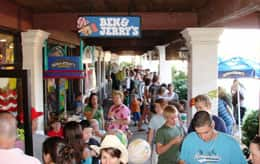 We’ll plan to do it all again next April, when we’ll also celebrate our 30th birthday! We hope to see you there!
We’ll plan to do it all again next April, when we’ll also celebrate our 30th birthday! We hope to see you there!
ENVIRONMENT
Managing Our Impacts
Since 1992 when Ben & Jerry’s signed the CERES principles, we have honored a commitment to support safe and sustainable  food production and minimize our negative impact on the environment. It’s important for us to continually integrate programs and practices that assure our product and operations stay consistent with our stated agricultural and environmental values.
food production and minimize our negative impact on the environment. It’s important for us to continually integrate programs and practices that assure our product and operations stay consistent with our stated agricultural and environmental values.
Since 2001, we have been pursuing programs that promote sustainable agriculture practices among dairy farmers. The Dairy Stewardship Alliance in Vermont and Caring Dairy, in the Netherlands are collaborative initiatives that help farmers as they pursue leading-edge practices.
As to the impact of our business on the environment, we’re active in a number of areas. We have continued to evaluate and develop the most environmentally progressive packaging available. In 2007 we continued our commitment to reduce our climate impacts around the world by pursuing increased energy efficiency in our supply chain, manufacturing plants, refrigeration systems, and product distribution systems. We continue to purchase carbon offsets as a part of our overall strategy to manage our climate impacts. We also calculated our Global Warming Social Footprint in the US and our Climate Hoofprint in the EU to help us measure whether we’re doing enough to respond to climate change.
Our Environmental Management System commits our manufacturing plants to establishing goals for measuring and reducing other environmental impacts. These areas include energy use and emissions, water use and wastewater management, solid waste and recycling, hazardous waste and high strength dairy waste. The plants establish annual reduction targets, maintain strict adherence to environmental regulations and complete environmental projects sponsored by our company Green Teams for both internal and community-based awareness and education.
Over the years, Ben & Jerry’s has developed and implemented various environmental initiatives. See our timeline to get the complete history of our program.
Towards Sustainable Agriculture
When you think about it, Ben & Jerry’s simply would not be Ben & Jerry’s if it weren’t for the family farms supplying the high quality dairy ingredients we depend on. That’s why we have long been committed to supporting sustainable practices in the dairy industry.
It’s our belief that sustainable agriculture is about making continuous improvements to existing farming practices in order to help make them more environmentally sound, socially just and economically viable. 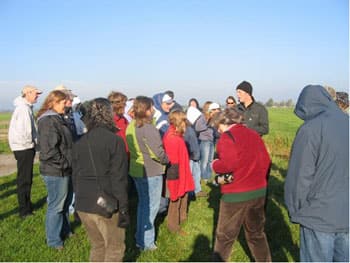 Our commitment to this ideal has taken on various forms over the years. In 2007, we continued our involvement in two ongoing projects in this area, one in Vermont and one in the Netherlands, where Ben & Jerry’s ice cream is manufactured for the European market.
Our commitment to this ideal has taken on various forms over the years. In 2007, we continued our involvement in two ongoing projects in this area, one in Vermont and one in the Netherlands, where Ben & Jerry’s ice cream is manufactured for the European market.
Dairy Stewardship Alliance (Vermont, USA)
The Dairy Stewardship Alliance (DSA) has been a collaborative effort between Ben & Jerry’s, the University of Vermont’s Center for Sustainable Agriculture, the 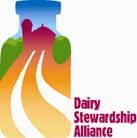 St. Albans Cooperative Creamery and the State of Vermont Agency of Agriculture since 2003. The goals of the DSA are to:
St. Albans Cooperative Creamery and the State of Vermont Agency of Agriculture since 2003. The goals of the DSA are to:
- Provide an on-farm self-assessment tool designed to enable farmers to more efficiently assess the social, environmental and economic aspects of their farm operations.
- Provide information to farmers about sustainable dairy farming practices.
- Provide a foundation for further development of programs that promote sustainable practices.
As a first step in 2003, we developed a comprehensive set of sustainability indicators for dairy farming, along with a set of Educational Modules that farmers could use to self-assess their farm management practices and performance over time. The Toolkit was officially launched in late 2004 with a group of farmer-members of the St. Albans Coop. Participating farmers used the toolkit to evaluate their practices, compare their results to other farms, and learn how to improve their results.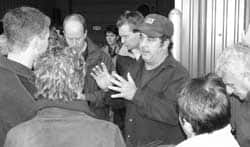
Since that time, we have grown the alliance to include more farmers, and we are currently in the middle of a project to transform the toolkit into an interactive online resource. We anticipate we will complete this work by the end of 2008, one year later than originally planned, due to limited staffing and financial resources.
To date the DSA has 25 participating farms with a goal of 52 by the end of 2008. Currently more than half of this group have finished the toolkit, identified two specific areas to improve on, and committed to make the indicated changes. Once these changes have been completed each farmer will reassess their operation and determine if their overall score has changed. Going forward, we will work with these farmers on continuous improvement.
In 2007 the Dairy Stewardship Alliance had reached a point where enough data from the previous years had been collected that we could analyze it more broadly. The results of this analysis show that DSA participating farmers are making changes on their farms that have positive outcomes to overall farm performance, particularly in the areas of animal husbandry, soil health and water management.
One of the highlights of the 2007 was the second year of the farmer exchange program with our Dutch farmer counterparts in the Netherlands that began in 2006. In October, thirteen farmers who are participating in DSA and their families were provided the opportunity to travel to the Netherlands. Together with the DSA advisory team, these farmers spent a week visiting Caring Dairy farms, connecting with farmers and learning about Dutch farming practices. The highlight of the week was the three days spent with host families on their farms. We made sure to match up the same Dutch and U.S. farmers from our 2006 Farmer Exchange, so the trip rekindled these growing friendships as well. The US farmers came home with a better understanding of a wide range of practices, including the potential for wind turbines and robotic milking machines on the farm.
Caring Dairy (The Netherlands)
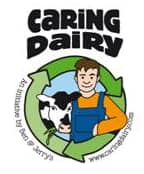 In the same spirit as the Dairy Stewardship Alliance, Ben & Jerry’s launched Caring Dairy in 2003, a collaborative project that works directly with dairy farmers in the Netherlands on continuous improvement of the environmental, social, and economic performance of their operations. Our partners in this effort include Unilever’s Sustainable Agriculture Initiative, our milk supplier, local farmers and Wageningen University.
In the same spirit as the Dairy Stewardship Alliance, Ben & Jerry’s launched Caring Dairy in 2003, a collaborative project that works directly with dairy farmers in the Netherlands on continuous improvement of the environmental, social, and economic performance of their operations. Our partners in this effort include Unilever’s Sustainable Agriculture Initiative, our milk supplier, local farmers and Wageningen University.
Caring Dairy helps farmers keep an eye on eleven indicators of sustainable dairy farming related to soil fertility and health, soil loss, nutrients, pest management, biodiversity, farm economics/value chain, energy, water, social/human factors, impact on local economy and animal welfare.
2007 was an exciting year for Caring Dairy,  as we started a partnership with CONO cheesemaker, a local cooperative with 550 dairy farmer members, producing a premium cheese under the Beemster brand. Under this arrangement, CONO will be Ben & Jerry’s sole dairy supplier for Europe, while all CONO farmers will use the Caring Dairy toolkit to drive continuous improvement towards sustainable practices. The visible symbol of this exciting partnership will be a Caring Dairy logo that will grace all Ben & Jerry’s products in Europe.
as we started a partnership with CONO cheesemaker, a local cooperative with 550 dairy farmer members, producing a premium cheese under the Beemster brand. Under this arrangement, CONO will be Ben & Jerry’s sole dairy supplier for Europe, while all CONO farmers will use the Caring Dairy toolkit to drive continuous improvement towards sustainable practices. The visible symbol of this exciting partnership will be a Caring Dairy logo that will grace all Ben & Jerry’s products in Europe.
 The partnership with CONO has allowed Caring Dairy to scale up from 11 to 550 farmers in one ambitious swoop. We launched the new relationship with a festive event in October, where CONO farmers and their families — 1300 people in all — were introduced in a lighthearted way to the goals of Caring Dairy and the added value it will bring to farmers. By distinguishing CONO products from competitors, the Caring Dairy program will result in a €1.00/100 kg price premium paid to farmers for their participation.
The partnership with CONO has allowed Caring Dairy to scale up from 11 to 550 farmers in one ambitious swoop. We launched the new relationship with a festive event in October, where CONO farmers and their families — 1300 people in all — were introduced in a lighthearted way to the goals of Caring Dairy and the added value it will bring to farmers. By distinguishing CONO products from competitors, the Caring Dairy program will result in a €1.00/100 kg price premium paid to farmers for their participation.
 Co-founder Jerry Greenfield also helped us get off to a great start with the CONO partnership by cheerfully agreeing to be interviewed by two cows on the history of the project.
Co-founder Jerry Greenfield also helped us get off to a great start with the CONO partnership by cheerfully agreeing to be interviewed by two cows on the history of the project.
We’re pleased that the impact of Caring Dairy is rippling outward from our initial group of participating farmers to CONO’s 550 dairy farmers with an ever-increasing impact on the sector as a whole. We continue active sharing of outcomes from Caring Dairy in the dairy industry, including in the Sustainable Agriculture Initiative Platform (SAI) Working Group on Dairy, a food sector initiative with over twenty global food companies.
You can learn more about the Caring Dairy program and listen to its participating farmers at https://www.benjerry.co.uk/values/how-we-do-business/caring-dairy.
EVERYTHING ABOUT ENERGY USE & AIR EMISSIONS
The various components of Ben & Jerry’s manufacturing process use three different forms of energy inputs: electricity, fuel oil, and natural gas. We measure and track the energy use at our plants as well as the resulting CO2 emissions.
Energy Use
The two primary facilities that produce Ben & Jerry’s ice cream and frozen yogurt in the United States are in Waterbury and St. Albans, Vermont. Ben & Jerry’s products for the European market are produced in Hellendoorn, The Netherlands. Here we present information that relates to the energy use of these three plants.
For information on the energy use and efficiency programs of our parent company, Unilever, please see the Sustainable Development report.
Vermont Plants
The energy sources for our Waterbury plant include fuel oil and electricity from Green Mountain Power. The St. Albans plant utilizes natural gas and electricity from Central Vermont Public Service Company. Both GMP and CVPS purchase most of their electricity from nuclear and hydroelectric generating plants, which are low CO2 emitting sources. However, there are other environmental issues associated with our energy sources. Ben & Jerry’s manufacturing plants measure all fuel used and the associated CO2 emissions.
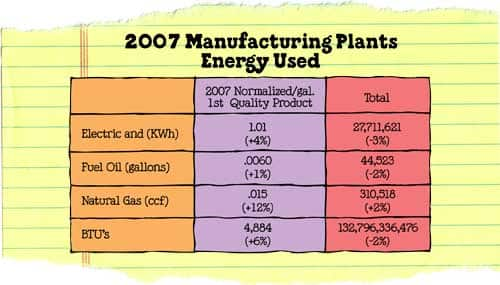
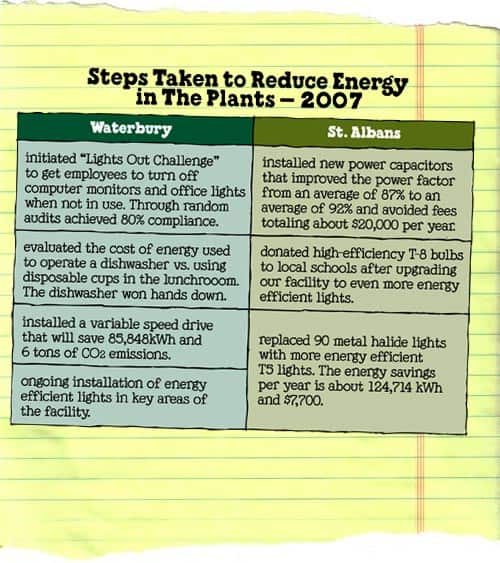
Hellendoorn Plant — The Netherlands
Ben & Jerry’s production accounts for about 45% of the total production of the Unilever plant in Hellendoorn. The data below represents the entire energy use of the plant, so we can’t take full credit — or all of the blame! — for the performance of this plant. Fortunately, the news is good. We reduced our energy use in 2007 by 3% below 2006 levels on a normalized basis, meaning we used less energy per tonne of production. This is the third consecutive year we’ve achieved energy reductions on a normalized basis.
On an absolute basis, our energy use increased by 7% which primarily reflects the strong growth of our production at Hellendoorn.
The plant purchases 100% renewable electricity generated from hydropower from electric supplier Essent.

Examples of 2007 energy-saving projects
- invested in quick-closing doors in our freezers to minimize cold loss.
- installed light tubes in all offices to harvest daylight.
- deployed movement sensors in infrequently visited rooms to turn off lights automatically.
- installed higher efficiency lightbulbs throughout the facility
- replaced cabinet freezers in quality assurance office with new high-efficiency models.
Greenhouse Gas Emissions
Background & Strategy
Scientists began to recognize in the early 1960s that increasing concentrations of greenhouse gases in the atmosphere would make the earth warmer. Since that time, rising levels of carbon dioxide primarily resulting from human activities have led to measurable global warming — and global climate change.
For many years, in response to this challenge, Ben &. Jerry’s has been striving to reduce our greenhouse gas emissions. Here’s how we’re acting on this commitment.
United States Areas of Focus
In our Vermont plants, we have identified several key areas of focus, including the following ongoing commitments:
- We will evaluate our refrigeration systems for maximum efficiency.
- We will seek assistance from outside sources including Efficiency Vermont to identify energy efficiency opportunities.
- We will evaluate alternative energy options.
- We will provide extensive educational information to our employees, customers and suppliers regarding actions everyone can take to reduce greenhouse gas emissions.
By year end 2006, we successfully achieved our five-year goal to reduce the carbon dioxide (CO2) emissions from our US manufacturing operations by 10%. We successfully achieved and exceeded this goal, reducing our normalized CO2 emissions by a total of 32% below 2002 levels by year-end 2006.
In 2007 we began to turn our attention to the emissions associated with our entire US value chain — from our supply chain upstream to the point of sale and downstream to disposal. We already know that most of the climate change impacts of our business happen outside of our manufacturing plants, so we laid the groundwork in 2007 to better understand the details. We intend to complete a carbon inventory to identify significant greenhouse gas emission sources and then we’ll chart an intelligent course forward. We plan to initiate the study in 2008.
Europe
In collaboration with the Dutch HIER campaign, the project of a consortium of nearly 40 NGOs, Ben & Jerry’s European business launched a ‘Climate Neutral Ice Cream’ project in 2007. This multi-year initiative focuses on four steps:
- Measuring the climate ‘hoofprint' of Ben & Jerry’s ice cream, from cow to cone.
- Reducing our Company’s use of natural resources through an aggressive five-year continuous improvement program.
- Converting our energy sources to renewable sources wherever possible.
- Offsetting all of the greenhouse gas emissions associated with our business by investing in Gold Standard renewable energy projects in developing countries.
2007 CO2 Emissions Performance
United States
In evaluating our CO2 emissions, we look at the data we collect in two different formats: normalized (CO2 emissions per gallon of product) and absolute (total tons of CO2 emissions).
On a normalized basis, the CO2 emissions from our Vermont plants increased in 2007 by 7% above 2006 levels. This result was largely due to lower production volume at our St. Albans plant, which reduced efficiencies.
On an absolute basis, CO2 emissions from our Vermont plants were flat from 2006 to 2007.
Read more about some of the changes we made in 2007.

The Netherlands
Ben & Jerry’s production accounts for approximately 45% of the total production of the manufacturing plant in Hellendoorn, The Netherlands. The data below represent the CO2 emissions of the entire plant — so we can’t take all of the credit for an excellent performance in 2007.
The Hellendoorn plant reduced its CO2 produced per metric tonne of ice cream by 8% from 2006 to 2007. This remarkable performance was the result of increased production efficiency at the plant and the payoff of efficiency investments made in the past year. Check out examples of the projects we initiated in 2007.
On an absolute basis, CO2 emissions at the Hellendoorn plant increased by 8% from 2006 to 2007, which primarily reflects the strong production growth in 2007.
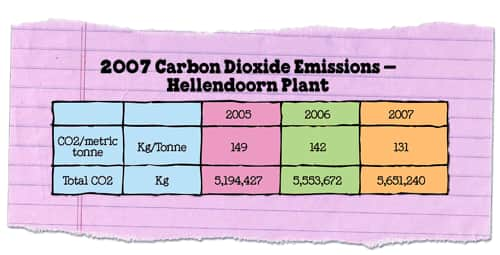
Carbon Offsets
A CO2 offset (also referred to as a green tag or carbon credit) is an environmental component of renewable energy. Energy is energy regardless of the source, but when there is a renewable component to it (such as wind, biogas, solar or hydro) there is a secondary value — the environmental benefit. Ben & Jerry’s purchase of these environmental attributes helps fund new renewable energy projects, and we use the clean energy environmental benefits to compensate — “offset” — the CO2 pollution from our energy sources that don’t come from renewable energy. In some cases, it can be the most cost-effective way to invest in the future of renewable energy.
United States Offsets
In 2007, Ben & Jerry’s offset 5,140 tons of CO2 emissions with NativeEnergy. This is equivalent to eliminating over million car10 miles, driving around the world 415 times, or removing 856 cars from the road for a year! It’s also the sixth year in a row that Ben & Jerry’s has offset 100% of the carbon emissions from our manufacturing operations and the second year for employee air travel.
Our recent US offset purchases have supported a variety of renewable energy projects initiated by Native American tribes, rural communities, and family farms, including: the Confederated Salish and Kootenai Tribes Boulder Creek Hydro Project; the Kasigluk Alaska Coastal Village Wind Project; the Wray School District Wind Turbine; Midwest Farmer Distributed Wind; and four family dairy farm waste methane-to-energy projects. We’ve been purchasing high quality offsets through NativeEnergy since 2002.
Europe Offsets
Carbon offsetting is an important part of our ‘Climate Neutral Ice Cream’ initiative in Europe as well. We’ve committed €2 million over five years to purchase high quality offsets for all of the emissions created in the process of making and selling Ben & Jerry’s ice cream in the EU, from cow to cone. The offsets will fund a variety of renewable energy projects in developing countries. In 2007, we purchased 26,600 voluntary carbon units (VCU) from South Pole Carbon Asset Management to fund a waste water project in Thailand.
Beginning in 2008, when they become available, Ben & Jerry’s EU business will purchase only “Gold Standard” offsets, which means that the projects funded meet rigorous criteria for delivering measurable carbon emissions reductions over and above a business-as-usual scenario.
Distribution & Transportation
Vermont’s Finest continues to operate seven delivery trucks as the local distribution arm of Ben & Jerry’s in northern New England. Now based out of our South Burlington office, 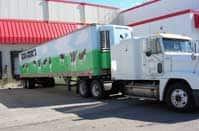 Vermont’s Finest trucks distribute both Good Humor-Breyers and Ben & Jerry’s products.
Vermont’s Finest trucks distribute both Good Humor-Breyers and Ben & Jerry’s products.
Our plant shuttles move ingredients between our two Vermont manufacturing sites in St. Albans and Waterbury. Emissions associated with these two functions are outlined below.
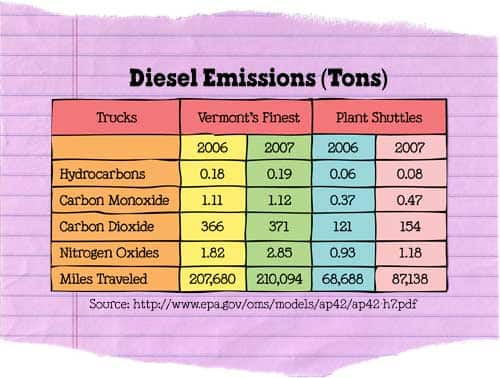
Ben & Jerry’s products are distributed nationally through a Unilever warehousing system. We do not currently calculate emissions associated with this system, although we will be including this in our 2008 carbon inventory project.
In the European Union, distribution of Ben & Jerry’s products contribute approximately 4% of the climate impacts of our business, according to analysis undertaken in 2007.
Global Warming Social Footprint
We have been working to reduce the global warming-causing greenhouse gas emissions that result from making Ben & Jerry’s ice cream for several years. Our efforts have included improving efficiencies, investigating the practicality of renewable energy, and offsetting all of the carbon emissions from our manufacturing operations.
But we haven’t been able to answer one very important question about our company’s response to global warming: Exactly how much should we be reducing our greenhouse gas emissions each year?
In 2006, Ben & Jerry’s began a focused effort to answer this huge question. It’s an important question because in order to successfully meet the challenge of global warming as a world community, we need a plan that will share the burden of reducing greenhouse gases in the atmosphere equitably among regions, nations, industries, and individuals.
We don’t have such a plan yet in the United States, where carbon dioxide, the most significant greenhouse gas, is not regulated by the federal government. (We’re pushing Congress to fix that through our Lick Global Warming Campaign).
So we looked to a plan that some of the best climate scientists in the world have proposed called the WRE350 Scenario. It spells out annual limits on the amount of carbon (in the form of carbon dioxide) humans can emit globally over the next 150 years in order to stabilize the concentration of carbon dioxide in the atmosphere at a safe level of 350 parts per million. (A number of other proposed plans aim for higher levels of atmospheric carbon dioxide, ranging from 450 to 750 parts per million. We chose the most aggressive plan, which we think represents the best response to global warming.)
Then, in consultation with the Center for Sustainable Innovation, we used a new analytical technique, the Global Warming Social Footprint, to figure out what the WRE350 Scenario meant for Ben & Jerry’s. The purpose of the project was to identify an annual level of carbon emissions that our Company’s Vermont manufacturing operations could emit (in the form of carbon dioxide) that would represent our proportionate share of the WRE350 Scenario.
It is our belief that if every business calculated a Global Warming Social Footprint and developed aggressive plans to meet its annual emissions targets, then our planet would have the ability to safely assimilate human-produced carbon emissions, resulting in stable levels of atmospheric carbon dioxide by 2150. While a lofty goal, we need to start someplace.
What we found in 2007 is that we reduced the global warming footprint of our Vermont plants a good bit faster than the WRE350 Scenario requires in the years from 2005-2007. Ben & Jerry’s manufacturing operations at our Vermont plants were responsible for 2,197 net tons of carbon emissions in the form of carbon dioxide over the two years from 2006-2007, which is 665 tons less carbon than our share of the WRE350 Scenario allows, based on a 2005 baseline. Our carbon emissions were therefore 19.7% lower than the cumulative limit set by the WRE350 Scenario in these years.
We’re glad to learn this news about our recent performance. It reflects the value of our Company’s investments in energy efficiency and carbon offsets over the years, as well as slightly reduced production in the years 2006-2007. But we know that the long-term effort to reduce our emissions to respond effectively to the challenge of global warming will require even greater efforts in the years ahead. Learn more about our ongoing efforts.
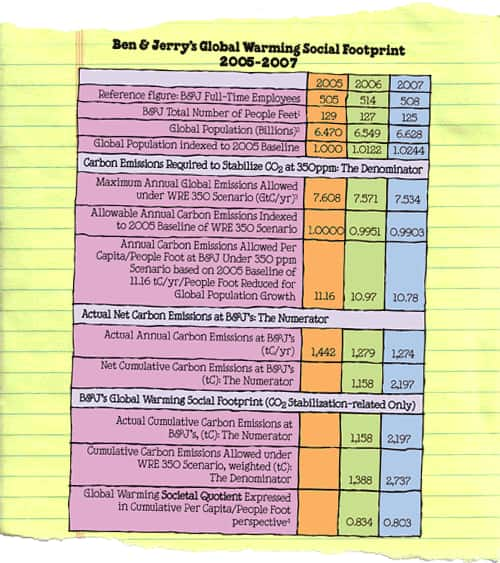
1 People Feet are an alternative measure of headcount. See www.sustainableinnovation.org/Global-Warming-Footprint.pdf
2 World population data from US Census Bureau at
http://www.census.gov/ipc/www/idb/worldpop.html
3 Source: MAGIC/SCENGEN emissions library at www.cgd.ucar.edu/cas/wigley/magicc
4 <=1 = Sustainable; >1 = Unsustainable
Learn more about the Social Footprint methodology and our partners at the Center for Sustainable Innovation.
PACKAGING
A New Pint for the US market
In 2007 we completed the transition to a new pint container, replacing the unbleached Eco-Pint that we had used for several years. The market for unbleached packaging never grew much beyond Ben & Jerry’s, so we ran into increasing supply, quality, and cost challenges. Our new container is made out of a bleached paperboard that has superior forming characteristics. The transition will also allow us to eliminate approximately 1,000 tons of waste annually from our packaging supply chain. Also, the technology for bleaching paper has improved significantly in the last ten years, reducing the associated environmental impacts. In addition, our new supplier has an excellent track record of sustainable forestry practices. We feel the transition away from the Eco-Pint is a necessary step sideways so we can keep moving forward on our journey to reduce the environmental impacts of the packaging we use for our pints.
We did not reach one of our goals for 2007, which was to achieve Forest Stewardship Council (FSC) certification for this new pint container in the United States. (FSC certification is a rigorous, third-party guarantee that wood and paper products are sourced from forests that are sustainably managed.) This project was delayed several times as some of our sister businesses within North American Ice Cream faced difficult financial situations in 2007, and funding for Ben & Jerry’s to pursue FSC certification was not approved at the NAIC level until late 2007. This project was delayed several times due to funding constraints in 2007, but we remain committed to this goal and the transition to FSC certified paperboard should be completed in 2008.
Scoop Shop Packaging
The packaging used in Ben & Jerry’s Scoop Shops includes a wide variety of cold drink cups and various ice cream bowl sizes as well as spoons, straws, napkins and lids. Where we have been able to make substitutions for more environmentally sound choices, we’ve made the changes. That has been the case with our polyethylene cups and paper napkins made from 100% unbleached, recycled content. However, our ultimate goal is to find a 100% renewable material for all of our Scoop Shop packaging.
In 2007, transitioned our drink cup line to green-ware that uses a renewable corn-based resin. The package explains that we support the use of renewable resources for the cups and that they can be composted where commercial compost facilities are available. We recognize that the availability of commercial compost facilities are limited, but we believe it is important to raise the awareness that there are alternatives to non-renewable petroleum based products.
Going forward, we will continue to evaluate all of the packaging used in our Scoop Shops, including these corn-based cups, to make sure we’re using environmentally responsible materials.
ENVIRONMENTAL MANAGEMENT
Beginning in 2002, Ben & Jerry’s manufacturing sites initiated the development of an environmental management system that followed Unilever’s framework standards. These framework standards closely parallel the ISO14001 management system and 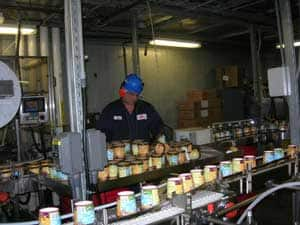 have proven to be a useful strategy by providing a single resource for all plant-related environmental information. Specifically, the framework standards are important for identifying training needs and ensuring regulatory compliance. At the beginning of each year, their content is reviewed by Ben & Jerry’s Environmental Coordinators and the Manager of Natural Resources. The standards are then maintained by the Environmental Coordinators and are updated on a regular basis as needed.
have proven to be a useful strategy by providing a single resource for all plant-related environmental information. Specifically, the framework standards are important for identifying training needs and ensuring regulatory compliance. At the beginning of each year, their content is reviewed by Ben & Jerry’s Environmental Coordinators and the Manager of Natural Resources. The standards are then maintained by the Environmental Coordinators and are updated on a regular basis as needed.
Unilever completes an annual Environmental Performance Review (EPR), also known as the Proforma. The Proforma collects environmental data from all the worldwide operating sites and compiles it in Unilever’s annual Sustainable Development Report. All of Unilever’s operating facilities utilize both the framework standards and the Proforma. Read the Unilever report here.
Water Use & Waste Water
WATER USE
U.S. Production — Vermont Plants
Water is a significant input for Ben & Jerry’s ice cream production process. While our Vermont manufacturing plants operate in a relatively water-abundant part of the country, 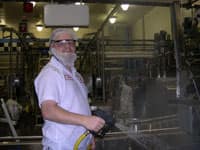 we are keenly aware of the need to manage our Company’s use of this essential natural resource carefully. We monitor our fresh water consumption and our wastewater discharge as key factors in our environmental performance.
we are keenly aware of the need to manage our Company’s use of this essential natural resource carefully. We monitor our fresh water consumption and our wastewater discharge as key factors in our environmental performance.
The water we use to clean our production room and its equipment must be managed according to state and federal regulations. This wastewater contains byproducts from our production process, including spilled ingredients such as sugar, dairy, and add-ins (chocolate chunks, nuts, and fruit), as well as cleaning chemicals. To maintain compliance with our regulatory permits, each manufacturing plant has developed waste minimization programs to reduce the amount of waste discharged.
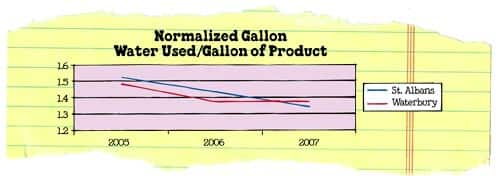
In 2007, our St. Albans plant established a water use reduction goal of 1.40 gallons of water used per gallon of finished product produced. The plant finished the year with a successful result of 1.34 gallons of water  use per gallon of finished product, a 5% reduction. The success was based upon ongoing implementation of conservation programs and employee awareness.
use per gallon of finished product, a 5% reduction. The success was based upon ongoing implementation of conservation programs and employee awareness.
Ben & Jerry’s Waterbury plant doesn’t set a water use reduction goal because they are a tourist destination location. Water that comes into the plant is not metered separately for the tourist area and the production facility.
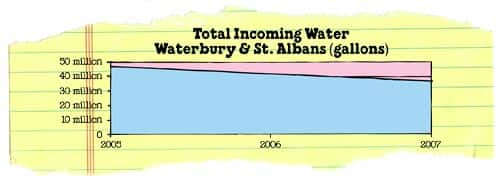
European Production — Hellendoorn, The Netherlands Plant
We reduced our water use in the Hellendoorn plant by 8% from 2006 to 2007 on a normalized basis, narrowly missing our goal of 2.4 cubic meters of water per metric tonne of ice cream.
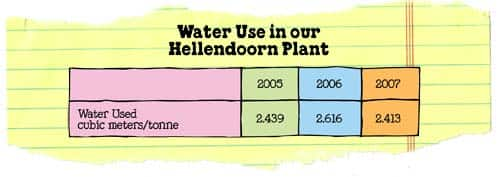
WASTE WATER
U.S. Production — Vermont Plants
Annual wastewater goals are established at our Waterbury and St. Albans facilities to reduce the amount of water discharged to the respective towns’ municipal wastewater treatment plants. These goals are shown in the table below. The Waterbury plant is required to pre-treat their wastewater prior to discharge. This is accomplished through the use of a Dissolved Air Flotation (DAF) unit followed by an aerobic biological lagoon to treat the waste to regulated discharge levels. The St. Albans Plant discharges directly to the municipal treatment plant.
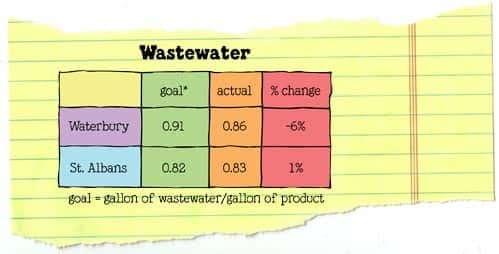
In 2007, both manufacturing plants generated more wastewater per gallon of ice cream produced than in 2006, with St. Albans up 1% and Waterbury up 3%. Both plants have continued to make improvements in their operating systems to reduce the generation of wastewater, so decreased production volume in 2007 was the main reason for these results, since our plants are most efficient at high volumes. The plants continue to work towards more efficient cleaning processes and greater employee awareness on water use that generates waste.
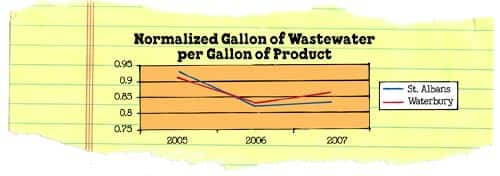

European production — Hellendoorn, The Netherlands plant
All of the wastewater generated at our Hellendoorn plant is handled by municipal facilities. The chemical oxygen demand (COD) of this wastewater increased significantly on an absolute and a normalized basis in 2007. Our goal going forward will be to find ways to reduce the amount of COD reaching the municipal treatment plant.
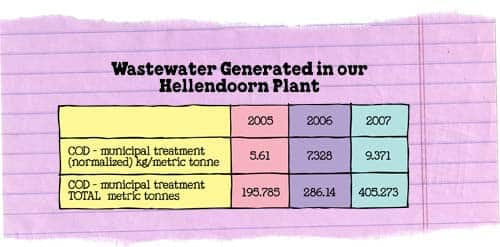
Product Waste Management
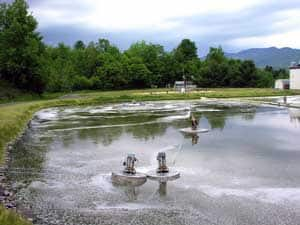 Product waste, otherwise known as High Strength Dairy Waste (HSDW), represents one of the Company’s greatest environmental impacts. Ice cream contains many ingredients with high levels of sugar and fat which, without proper management at a wastewater treatment facility, can negatively impact aquatic environments.
Product waste, otherwise known as High Strength Dairy Waste (HSDW), represents one of the Company’s greatest environmental impacts. Ice cream contains many ingredients with high levels of sugar and fat which, without proper management at a wastewater treatment facility, can negatively impact aquatic environments.
U.S. Production — Vermont Plants
Overall, we reduced the amount of high strength dairy waste generated by our Vermont plants on a normalized basis in 2007. Our Waterbury manufacturing plant performed significantly better than its goal, reducing its HSDW by 23% below 2006 levels. This more than offset the 2% increase in the St. Albans plant in 2007, as indicated in the table below. Reductions in Waterbury were achieved through on-going efficiencies and attention to waste reduction, while the St. Albans performance was hampered by a lower total production volume, which tends to make normalized goals very difficult to achieve.

In 2007 we began to send some of our HSDW to methane digesters that use the waste materials to produce methane gas, which can be burned to create electricity and heat. We now manage our HSDW in three ways:
- through the use of permitted manure pits on Vermont farms;
- through the Intervale Center’s composting facility in Burlington Vermont
- through farm methane digesters
The following chart shows how much HSDW we managed through our two options:

European Production — Hellendoorn plant
In The Netherlands, we send our dairy waste to a nearby farm, where it is fed to pigs. In 2007, this totaled 1,384 metric tons, which made a lot of pigs happy!
Solid Waste Management
Ben & Jerry’s tracks and measures the amount of solid waste and recycled material generated at our manufacturing plants. Recycled material, though diverted from the landfill, is still considered a solid waste. We measure the percent of recycled material as a percentage of the total solid waste stream on an annual basis. While our goal is to achieve source reduction, we still work hard at improving the amount of material that we recycle.
Overall in 2007, the Company’s Vermont plants generated 5% more solid waste per gallon of ice cream relative to 2006, while the percentage of solid waste we were able to recycle decreased slightly to 61%.
This increase in solid waste happened because the St. Albans plant did not reach its goal, seeing an increase of 8% more solid waste generated per gallon of product than in 2006. This was due largely to lower production volumes in St. Albans in 2007, which made production less efficient.
In 2007, the Waterbury plant reduced solid waste by 3% per gallon of product, a strong performance. Though we are dedicated to reducing waste and errors, there are unavoidable events that do require product disposal, and unfortunately we experienced more of these events in 2007 than the previous year which caused the significant increase.
Hazardous Waste Management
United States Summary
Given the small amount of hazardous material the Company generates, Ben & Jerry’s is considered an Exempt Small Quantity Generator (ESQG). This means that we do not generate more than 220 pounds of hazardous waste or 2.2 lbs of acutely hazardous waste on a monthly basis. The hazardous waste generated at Ben & Jerry’s facilities consists almost entirely of waste oil, water from maintaining boilers and compressors, and a small amount of methyl ethyl ketone (MEK), as detailed in the table below. The State of Vermont regulates waste oil as a hazardous waste unless it is recycled. Overall, we continue to seek innovations in our plant technologies that will ultimately eliminate any hazardous waste.

European Production — The Netherlands
We produced much more hazardous waste at our Hellendoorn plant in 2007 than in previous years on an absolute and a normalized basis. This reflects new reporting requirements required by local law that treat some empty containers as hazardous.
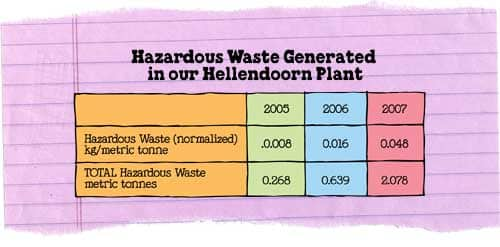
Regulatory Compliance
United States Compliance
The manufacturing plants are required to maintain environmental permits for:
- wastewater discharge parameters
- stormwater management
- high strength dairy waste management
- land application of solids from our lagoons
- underground storage tanks
We also submit information under community right-to-know laws regarding hazardous materials stored at our plants.
Ben & Jerry’s has not received any state or federal violations of these permits in the past three years and maintains an excellent record for regulatory compliance.
Greening Our Workplace
Each of Ben & Jerry’s Company sites have a Green Team comprised of employees interested in environmental issues. These employee-led teams come up with projects, activities and events tha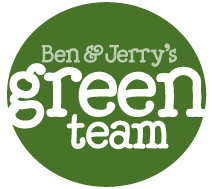 t highlight relevant environmental issues within the Company and beyond.
t highlight relevant environmental issues within the Company and beyond.
Vermont
In 2007, Company Green Teams at our Vermont sites initiated the following projects to support community and employee environmental awareness and action:
- Earth Day celebrations with daily environmental tips
- Corporate Sponsor for “Vermont Green Up Day” in which employees participated in road clean-up projects near their facility
- Arbor Day celebration — young spruce tree give-away to employees
- “Pedal for Progress” — a nonprofit that collects bikes and donates them to underprivileged people throughout the world who need bikes to get to jobs, attend school or get produce to market
- “Environmental Tidbits” — regular e-mail topics focused on environmental issues that employees may find interesting
- “Curb Your Emissions” — ride-share challenge, in which employees who successfully car pooled over a period of time received a $50 gas card.
- Tire Inflation Day — event to properly inflate employees’ car tires to improve car mileage and reduce GHG emissions.
Europe - Green Team
The Green Team at the Ben & Jerry’s plant in Hellendoorn, The Netherlands is responsible for driving projects that reduce our environmental impacts throughout the factory. In 2007, this Green Team accomplished the following:
- Quick-closing freezer doors were installed in the freezers to minimize cold loss
- Light tubes were installed to collect natural daylight. Motion sensors were installed in minimally-used spaces and energy efficient lighting replaced current light fixtures
- “Pigs on diet” project was begun to improve the production line efficiency to create less waste ice cream that ends up as pig feed
- Plastics recycling program was successfully launched
- Nozzles were installed on all hoses to reduce water use for washing floors
- Freezers that hold ice cream for quality testing were replaced with new, more efficient models
WORKPLACE
GOOD WORK
2007 shaped up to be a relatively stable year for Ben & Jerry’s. Unlike the previous few years, we experienced no significant restructuring within our organization. Some changes were made to the Retail Organization team to improve overall operations, which did lead to a few employees being let go. In keeping with our values, we took great care to ensure these individuals were afforded our deep respect and assistance to support their transitions out of the Company.
In 2006, our parent company, Unilever, announced a plan to outsource worldwide HR functions, which continued into 2007. The “Human Resources Transformation” project, or HRT, is intended to streamline processes and relies heavily on manager and employee self-service. This has required the closer alignment of Ben & Jerry’s people practices with the rest of Unilever North America. Most notably in 2007, the HRT required a shift in our recruiting practices and benefits administration to third party administrators. This was a significant change for us, and as is often the case, some employees embraced the empowerment of self-reliance, while others expressed a preference for in-house management of HR functions.
These changes in HR are just one part of a broader move in our Company towards outsourcing business functions or relying more heavily on employee self-service. Taken together, these shifts have changed our ways of working significantly. Most employees have adapted to the changes smoothly, although many would agree that basic tasks now require more time and energy — and sometimes compete with our ability to do our ice cream-related tasks.
Compensation
At Ben & Jerry’s we believe the Company’s financial success should be shared by all stakeholders rather than concentrated at the top of our management structure. Part of the Company’s Economic Mission is to create career opportunities and financial rewards for our employees, a commitment in line with our Social Mission.
Livable Wages
Ben & Jerry’s is committed to paying all of its full-time manufacturing workers a livable wage. In 1995 we established a method for calculating a livable wage benchmark for Vermont. We defined it as the starting wage for a single person that will sustain a quality of life to include expenditures for housing, utilities, out-of-pocket health care, transportation, food, recreation, savings, taxes, and miscellaneous expenses. Since then, we’ve adjusted this livable wage annually to ensure the relative value is sustained in today’s marketplace.
Ben & Jerry’s livable wage benchmark for 2007 was $12.42 per hour. This translates to $25,833.60 per year. For comparison, in 2007, the minimum wage in Vermont was $7.53/hr ($15,662/yr) and the national minimum wage was $5.85/hr ($12,168/yr).
Bonus Incentive Plans
Every full-time Ben & Jerry’s employee is eligible for some form of variable pay over and above their base pay. The bonus plans provide an added incentive to achieve sound business results and to build skills and competencies within the Company.
In 2007, Ben & Jerry’s salaried exempt employees, salaried non-exempt employees and managers were eligible for the Variable Pay Award (VPA) plan which allocates bonuses based on the Company’s financial performance and the individual’s progress on goals and targets.
Ben & Jerry’s full-time hourly manufacturing employees were eligible for bonuses and incentives in 2007 through a “Keys to Enterprise” (KTE) plan administered by North American Ice Cream (NAIC), our operating division within Unilever. The KTE payout in 2007 included cash; ‘Ben Bucks,’ our own in-house currency which can be redeemed in company stores; and other awards. The total value of the KTE payout in our Vermont plants in 2007 averaged $474 per employee, down from $533 in 2006. This slightly lower payout in 2007 reflects the weaker performance of the whole North American Ice Cream business in 2007.
Benefits
More Than a Paycheck
The benefits package for Ben & Jerry’s employees saw little change in 2007. The basic benefits such as health insurance and personal time are defined and managed by our parent company, Unilever. Ben & Jerry’s still offers some unique benefits over and above Unilever’s package, too. Altogether, our benefits remain competitive within the industry and represent an important part of our relationship with employees. Here’s a quick view of a few of our favorites:
- generous paid time off
- a 401 (k) plan with a 5% Company match
- a choice of health insurance plans
- dental, health and life insurance
- onsite workout facility at Central Support Office
- 40 hours of paid time off for community service work (Central Support employees)
- education tuition reimbursement
- three free pints of ice cream per day
- health club membership
- $1,000 hybrid automobile purchase incentive
- a pet-friendly workplace (Central Support)
- DaVinci nap room for re-energizing
- Milky Way room for nursing moms
Benefits Cost
We are now using a simpler method to estimate the benefits cost for Ben & Jerry’s employees. Using this new formula, average benefits costs per employee totaled $12,785 in 2007. This compares to a figure of $12,349 for 2006, also using the new formula. We believe this modest increase reflects general economic trends.
(Note: The old formula determined that our 2006 average benefits cost was $12,667, very much in line with the results we’ll report going forward.)
Diversity & Gender Balance
DIVERSITY
Ben & Jerry’s believes in and promotes workplace diversity. We think we’re a better company when we can draw on different perspectives, backgrounds, and abilities among our employees. For example, in the spirit of welcoming diversity, for many years we’ve attracted individuals of varying sexual orientation; for just as long, we’ve offered benefits programs that recognize and support partnerships other than traditional marriage.
Historically, the workforce at our manufacturing plants and corporate offices has reflected the demographic patterns of Vermont, with relatively little racial diversity. In 2007, this continued to be true, as the diversity ratio within our Company was measured at 3.7%.
We continue to use critical tools, such as Equal Employment Opportunity (EEO) and Affirmative Action Plan (AAP) guidelines to track important diversity information. The 2007 Ben & Jerry’s Affirmative Action Plan for Minorities and Women results indicated that there were no job groups among minorities or women experiencing statistically significant adverse impacts in promotions or terminations.

GENDER BALANCE
We are committed to gender equity in our employment practices. In 2007, 64% of our full-time workforce was male and 36% was female, which represents a slight change from 2006, when we measured a 63-37 split.
We are also committed to compensating men and women equitably for equal work and service with the Company. Our Affirmative Action Plan helps us to analyze whether we are we are meeting this goal and provides input to our annual salary planning process.
In previous years, we have published data on gender salary equity in this report. At our publication deadline, this data was not available for 2007. We will revise this web page with data as soon as it is available.
Survey Says...
Unilever employees worldwide participate in a Global People Survey (GPS) contributing their feedback on a wide range of topics related to the Company’s performance and practices. The survey is a useful tool for taking the pulse of our employees, allowing us to better understand the relationship between our people, the organization, and our business development.
The Company completed a full GPS in 2007 for the first time in three years. In the 2004 survey, the results reflected a company in transition.
In 2007, key findings from Ben & Jerry’s employees surveyed in the GPS included:
- high ratings for Ben & Jerry’s Company leadership.
- significant employee concern about Unilever leadership. This may be partly a reflection of the survey’s timing, coming just weeks after a Unilever announcement that the North American Ice Cream business would be re-organized, creating a great deal of uncertainty, though it did not involve any organizational changes within Ben & Jerry’s.
- a continued concern among B&J’s employees about integration with Unilever relative to social mission and strategic leadership
- high scores for employee job satisfaction and pride in the company, tempered by low scores of employee commitment and optimism
Scores that changed significantly from 2004 include a decline in employee commitment and a notable rise in employee pride, two results that seem difficult to reconcile.
The results of this survey provide an interesting window into the life of our Company. Above all, we believe it reflects the fact that, seven years after the Unilever acquisition and with many significant changes behind us, Ben & Jerry’s as a Company is finding and embracing a new equilibrium that is once again a source of employee satisfaction and pride.
Company Culture
 Within our own backyard, we continue to value our niche as a unique brand with a unique style within the larger, more complex organization of Unilever. This approach is reflected in Ben & Jerry’s workplace practices and in our company culture. In our Central Support Office, we share company-sponsored employee lunches from time to time, hold fun and spontaneous celebrations organized by the Joy Gang and the Green Team, and get ice cream regularly at our very own Scoop U. Pets and kids are welcome in our office, too. We enjoy a wonderful exercise facility on site and a series of fitness classes in our office have helped many of us on our quest to turn the ice cream calories into endorphins! And, with management leading the way, we’ve continued to strive for a balance between work and personal commitments in a very busy workplace.
Within our own backyard, we continue to value our niche as a unique brand with a unique style within the larger, more complex organization of Unilever. This approach is reflected in Ben & Jerry’s workplace practices and in our company culture. In our Central Support Office, we share company-sponsored employee lunches from time to time, hold fun and spontaneous celebrations organized by the Joy Gang and the Green Team, and get ice cream regularly at our very own Scoop U. Pets and kids are welcome in our office, too. We enjoy a wonderful exercise facility on site and a series of fitness classes in our office have helped many of us on our quest to turn the ice cream calories into endorphins! And, with management leading the way, we’ve continued to strive for a balance between work and personal commitments in a very busy workplace.
Leadership
Through 2007, Ben & Jerry’s senior leadership team, known as the Managers of the Mission (MOM) continued to focus on their leadership skills by participating in additional training and development. The leadership development program was so successful that it was extended to twelve more managers in 2007. MOM evaluated their progress on development and the impact it had on their teams through self assessments and feedback from the twelve managers who participated in the program. A new MOM member joined the team this year and our leadership development also served as a way to integrate her as a member. This work has continued to infuse energy into our organization and our work.
Communication
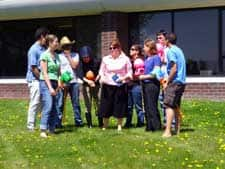 In 2007, we continued to implement programs that enhance ongoing communication processes and ensure a working environment that’s open to discussion and feedback. The MOM sponsored several “Town Meetings” throughout the year for information sharing on business issues. Site meetings, scheduled quarterly, kept all employees in touch with the Company’s business results and current priorities. The consensus was that these improved communications and were generally well received by employees.
In 2007, we continued to implement programs that enhance ongoing communication processes and ensure a working environment that’s open to discussion and feedback. The MOM sponsored several “Town Meetings” throughout the year for information sharing on business issues. Site meetings, scheduled quarterly, kept all employees in touch with the Company’s business results and current priorities. The consensus was that these improved communications and were generally well received by employees.
Employee Recognition
In an effort to foster on-going positive recognition for work well done, we continued to promote our Rewards and Recognition program in 2007. We are also committed to measuring the level of participation in these programs for 2008.
- The Service Award recognizes employees who’ve been at Ben & Jerry’s for five years and more through gifts, cash, and/or travel vouchers in a tiered system. In 2007, 49 employees were awarded Service Awards.
- The Busted Hump award gives employees an opportunity to recognize their peers for timely and tangible “everyday” contributions to our business and to our values-led mission. Recognized employees receive a certificate of appreciation and a gift certificate to a local establishment valued at $50. In 2007, 61 employees were awarded Busted Hump Awards.
- The Golden Cone Award, given annually, is an opportunity for the Company to recognize, reward and celebrate employees for truly exceptional contributions that enhance the business while still preserving and promoting Ben & Jerry’s culture, Social Mission and organizational values. Recipients of this prestigious award receive an engraved statue and a cash gift of approximately $2,000. In 2007, two employees were awarded the Golden Cone.
- The Applause Pause is an award to recognize and celebrate a fellow employee’s positive contribution with a spontaneous financial pat on the back. The award includes a certificate of appreciation and Ben Bucks (up to $25.00 equivalent) for recognized employees, all redeemable at the Unilever Employee Store and most Ben & Jerry’s Scoop Shops.
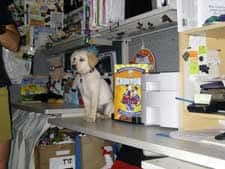 In addition to these “formalized” recognition programs, we continued with Hats ’N Cones at quarterly Site Meetings to honor employees for each completed year of service with the Company.
In addition to these “formalized” recognition programs, we continued with Hats ’N Cones at quarterly Site Meetings to honor employees for each completed year of service with the Company.
Turnover
Total Ben & Jerry’s employee turnover for the year, excluding those receiving severance, was recorded at 12.8% in 2007 compared to 12.3% in 2006. This number is lower than the 14.9% average turnover for manufacturing businesses in the Northeast.
GIVING BACK
A FOUNDING BELIEF
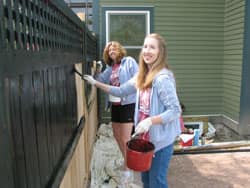 Company co-founder Ben Cohen once said, “Business has a responsibility to give back to the community.” Not only did that sentence make a good bumper sticker; it has inspired us over the years to think carefully about the many communities where we have a presence — and the meaningful ways we can make a contribution to their quality of life.
Company co-founder Ben Cohen once said, “Business has a responsibility to give back to the community.” Not only did that sentence make a good bumper sticker; it has inspired us over the years to think carefully about the many communities where we have a presence — and the meaningful ways we can make a contribution to their quality of life.
THE BEN & JERRY’S FOUNDATION
Some of the profits of Ben & Jerry’s business go directly to the Ben & Jerry’s Foundation, which makes grants to grassroots organizations around the country addressing social and environmental problems.
PRODUCT DONATIONS
We also make product donations to support the work of a wide range of nonprofit organizations in Vermont and across the country.
FACTORY SECONDS PROGRAM
Within Vermont, we have a unique relationship with dozens of convenience stores that sell our factory seconds — ice cream that doesn’t quite meet our highest quality standards — to benefit local service organizations.
COMMUNITY ACTION
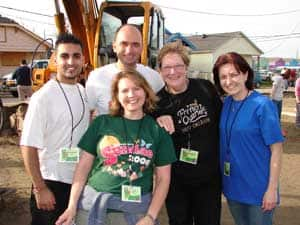 Each year, our employees share their talents with nonprofit organizations through company-sponsored community service projects and individual volunteer efforts. Read about how we got involved in 2007.
Each year, our employees share their talents with nonprofit organizations through company-sponsored community service projects and individual volunteer efforts. Read about how we got involved in 2007.
You might notice that we haven’t changed much about these community initiatives in recent years. We’re pleased with the flexibility these programs offer us to reach out to our neighbors in timely ways on a range of important issues. 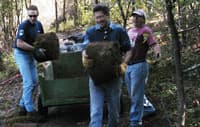 While we always have our eyes open for new opportunities, we’re satisfied with the impact that we’ve had working through these channels.
While we always have our eyes open for new opportunities, we’re satisfied with the impact that we’ve had working through these channels.
The Ben & Jerry’s Foundation
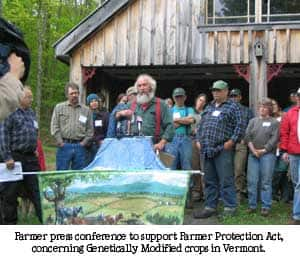 The Ben & Jerry’s Foundation, a separate entity from the Company, was established in 1985 through a donation of stock in Ben & Jerry’s Homemade, Inc. Its mission is to make the world a better place by empowering Ben & Jerry’s employees to use available resources to support and encourage organizations that are working towards eliminating the underlying causes of environmental and social problems. Its core areas of interest include economic and social justice, environmental stewardship, and peace through understanding in Vermont and other communities throughout the United States.
The Ben & Jerry’s Foundation, a separate entity from the Company, was established in 1985 through a donation of stock in Ben & Jerry’s Homemade, Inc. Its mission is to make the world a better place by empowering Ben & Jerry’s employees to use available resources to support and encourage organizations that are working towards eliminating the underlying causes of environmental and social problems. Its core areas of interest include economic and social justice, environmental stewardship, and peace through understanding in Vermont and other communities throughout the United States.
Visit the website of Ben & Jerry’s Foundation.
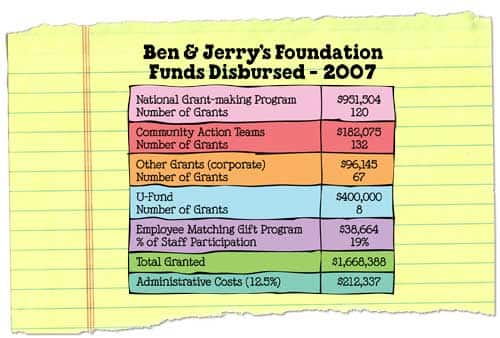
Funding
In 2007, the Ben & Jerry’s Foundation received $1,699,684 from Ben & Jerry’s Homemade, Inc., based on 2006 sales of the Company. This represents a 9.3% increase over the previous year.
Employee-directed grantmaking
Most of the grants awarded to nonprofit organizations by the Ben & Jerry’s Foundation each year are directed by Ben & Jerry’s employees. In 2007, these grants totaled $1,172,243.
The U Fund
The Ben & Jerry’s Foundation trustees make grants to organizations involved in education and activism around globalization and social justice from a special fund that was established when Unilever acquired Ben & Jerry’s in 2000. Learn more.
Other grants
Learn about the Plant Managers’ Discretionary funds and other small grants the Foundation makes.
Community Action Teams
Each of the Company’s Vermont sites (Waterbury, St. Albans, South Burlington) has an employee Community Action Team (CAT) that directs the energies of Ben & Jerry’s employees toward community improvement projects.
Grant recipient spotlight:
Though we don’t have the space to write about all of the groups we fund, these three groups represent some of the important work that the Ben & Jerry’s Foundation is proud to support.
The Western Lands Project received a $5,000 grant from the Ben & Jerry’s Foundation in 2007 to support its work monitoring and challenging efforts to privatize public lands in the West, 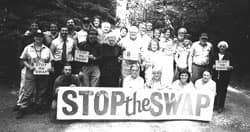 including federal land exchanges, sales, and giveaways that would cede public control of land to non-federal entities. The Project provides outreach, education, advocacy and legal assistance as needed to groups throughout the U.S. who request their help in responding to bad land deals.
including federal land exchanges, sales, and giveaways that would cede public control of land to non-federal entities. The Project provides outreach, education, advocacy and legal assistance as needed to groups throughout the U.S. who request their help in responding to bad land deals.
SmartMeme received a $10,000 grant in 2007. SmartMeme uses the power of narrative to connect the struggles for democracy, peace, justice and ecological sanity, thereby amplifying the impact of grassroots 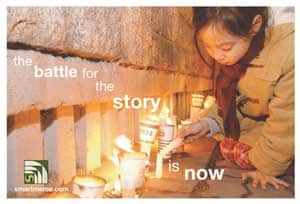 organizing. Ben & Jerry’s Foundation provided funding for the STORY project, a youth training and movement-building initiative; and for collaborative work with Iraq Veterans Against the War and young peace activists. Watch a clip about the STORY Project.
organizing. Ben & Jerry’s Foundation provided funding for the STORY project, a youth training and movement-building initiative; and for collaborative work with Iraq Veterans Against the War and young peace activists. Watch a clip about the STORY Project.
The Foundation supported the Latino Union of Chicago with a $10,000 grant in 2007. Founded by women day laborers, the Union collaborates with low-income immigrant workers to develop the tools necessary to collectively improve social and economic conditions. The Union also uses grassroots strength to promote pro-immigrant worker policies locally, state-wide, and nationally. Watch a short video about the work of the Latino Union of Chicago.
EMPLOYEE DIRECTED GRANTS
Ben & Jerry’s employees are extensively involved in the grant-making activities of the Ben & Jerry’s Foundation because the Foundation’s monies derive from the hard work of the Company’s staff. The Foundation administers three programs that award grants under the direction of Ben & Jerry’s employees.
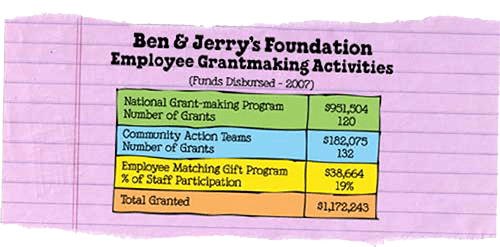
National Grant-making Program
A nine-member Employee Grant-making Committee representing each of the three Ben & Jerry’s sites in Vermont makes grants to national and Vermont-based nonprofit organizations to support progressive social change and environmental work. Members volunteer to join the committee and are selected by Foundation staff. They are expected to serve three-year terms. Grants are made ten times a year and range from $500 to $15,000.
In 2007 the National Grant-making Program distributed $951,504 in grants.
A complete list of national grants can be found on the Foundation website
Multi-Year Capacity-Building Grant
In 2007, Ben & Jerry’s Foundation piloted our first ever  multi-year grant for Vermont-based, Vermont-focused nonprofit organizations that meet our overall mission of working for progressive social change through a grassroots organizing strategy. The grant provides a maximum of $25,000 per year for up to three years for capacity-building purposes.
multi-year grant for Vermont-based, Vermont-focused nonprofit organizations that meet our overall mission of working for progressive social change through a grassroots organizing strategy. The grant provides a maximum of $25,000 per year for up to three years for capacity-building purposes.
Our first grant was awarded to Rural Vermont, a statewide, farmer-led organization that is working to promote and achieve a vision of a sustainable, thriving Vermont agricultural system that supports small farms and rural communities. This grant will help Rural Vermont expand and improve their grassroots funding base and build long-term stability.
Vemont Community Action Teams
Each of the Company’s Vermont sites (Waterbury, St. Albans, South Burlington) also has an employee Community Action Team or CAT. These teams review and decide on small grant requests, generally $100 to $1,000, to support the work of local, Vermont-based, nonprofit organizations.
In 2007 the three Community Action Teams distributed $182,075 in grants to organizations such as:
- Vermont Food Bank
- Twinfield Union High School
- Community Health Center of Burlington
- Siskin Ecological Adventures
Employee Matching Gift Program
In order to encourage and support employees’ personal generosity, the Ben & Jerry’s Foundation initiated an Employee Matching Gift Program in 1998. When employees make donations to nonprofits of their own choice, the Foundation matches dollar-for-dollar up to $2,000 per employee annually.
In 2007, 19% of staff participated and the Ben & Jerry’s Foundation matched $38,664 in employee donations.
THE U FUND
The trustees of the Ben & Jerry’s Foundation oversee and administer a one-time, $5 million gift that resulted from Unilever’s acquisition of Ben & Jerry’s in 2000. These funds are granted proactively to nonprofit organizations that support citizen education and activism around globalization issues and social justice.
In 2007 the Trustees distributed $400,000 in U Fund grants to eight organizations.
- Jobs with Justice ($25,000) — JwJ was founded in 1987 with the vision of lifting up workers’ rights struggles as part of a larger campaign for economic and social justice.
- Children’s Defense Fund ($100,000) — CDF provides a strong, effective voice for all the children of America who cannot vote, lobby, or speak for themselves. CDF pays particular attention to the needs of poor, disabled and minority children and encourages preventive investment before children get sick or into trouble, drop out of school, or suffer family breakdown.
- Center for Community Change ($50,000) — Founded in 1968 to honor the life and values of Robert F. Kennedy, the Center is one of the longest-standing champions for low-income people and communities of color. Together, expert staff and dynamic partners confront the vital issues of today and build the social movements of tomorrow.
- Village at Ithaca ($40,000) — The mission of the Village at Ithaca is to advocate for excellence and equity in the Ithaca City School District by developing strategic community relationships to ensure that students, particularly Black, Latino, and low-income, consistently meet or exceed district and state standards of achievement. Foundation funds will be given over four years.
- The Ruckus Society ($10,000) — The Ruckus Society provides environmental, human rights, and social justice organizers with the tools, training, and support needed to achieve their goals. Foundation funding was given to support the youth camp at the US Social Forum.
- Business Leaders for Sensible Priorities ($50,000) — The mission of BLSP is to change US budget priorities to reflect a national commitment to education, healthcare, energy independence, job training and deficit reduction — at no additional taxpayer expense — by eliminating funding for unneeded Cold War era weapons systems.
- Rainforest Action Network ($25,000) — Foundation funding was used to support RAN’s efforts to build a coalition of traditional and non-traditional allies to achieve the common goals of the Global Finance and Jumpstart Ford Campaigns. These campaigns work to pressure U.S. companies in the private financial and auto sectors, respectively, to adopt comprehensive commitments to protect forests, decelerate climate change, and support indigenous and otherwise affected communities around the world.
- United for a Fair Economy ($100,000) — UFE is a national organization working to raise awareness of the ways that concentrated wealth and power undermine the economy, corrupt democracy, deepen the racial divide, and tear communities apart. UFE supports and helps build social movements for greater equality.
OTHER GRANTS
Other Foundation Grants
The Foundation trustees and staff may make grants to nonprofit organizations in the areas of children and families, environmental restoration, sustainable agriculture and peace through understanding; or, in support of the Company’s Social Mission initiatives. Grants to support the Company’s Social Mission programs are not used for sponsorships, promotions or other marketing purposes.
In 2007, $96,145 was distributed in other grants to various organizations including:
- $5,000 to Vermont Workers Center to send constituents to the US Social Forum in Atlanta.
- $5,000 to Voices for Vermont’s Children.
- $6,000 to the Environmental Grantmakers Association as fiscal sponsor for Annie Leonard’s Story of Stuff, a film about consumption and waste.
Plant Managers’ Discretionary Fund
$5,000 is made available each year to the plant managers at the St. Albans and Waterbury sites. The fund is used for corporate citizenship purposes and supports activities of local civic organizations that may not be eligible for Community Action Team (CAT) grants.
In 2007, the Plant Managers’ contributions included Green Mountain Habitat for Humanity.
OUR COMMUNITY ACTION TEAMS
 Along with its grant-making activities, the Ben & Jerry’s Foundation also organizes Community Action Teams (CATs) at each of the Company’s Vermont sites (Waterbury, St. Albans, South Burlington). These Ben & Jerry’s employee teams work with their site management to identify, undertake and underwrite community projects in cooperation with a 501c(3) approved Vermont nonprofit or a municipal entity. Members of the CATs are chosen by their peers and serve for three-year terms.
Along with its grant-making activities, the Ben & Jerry’s Foundation also organizes Community Action Teams (CATs) at each of the Company’s Vermont sites (Waterbury, St. Albans, South Burlington). These Ben & Jerry’s employee teams work with their site management to identify, undertake and underwrite community projects in cooperation with a 501c(3) approved Vermont nonprofit or a municipal entity. Members of the CATs are chosen by their peers and serve for three-year terms.
In 2007 the CAT community projects included:
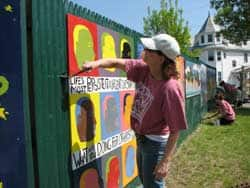
- trail marking at Groton State Forest in central Vermont
- constructing a nature playground at Thatcher Brook Elementary School in Waterbury, VT
- sorting food at the Barre Food Bank
- helping with forest and trail clean-up and ice rink maintenance in Morrisville, VT
- blazing trails and clearing paths at the community-owned Hard’ack ski and sled recreation area in St. Albans, Vermont
- helping seniors in the St. Albans area with home maintenance and winterization projects
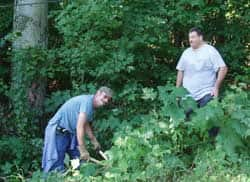 CATs also review and decide on small grant requests for local, Vermont based, nonprofit organizations.
CATs also review and decide on small grant requests for local, Vermont based, nonprofit organizations.
Giving it Away
 Lots of people think Ben & Jerry’s ice cream is a great excuse for getting together. That’s why we love to donate our ice cream to support the activities of nonprofit organizations around the country. It’s a way we help all kinds of groups celebrate a special event, draw a crowd to raise awareness of an important issue, or advance fundraising efforts.
Lots of people think Ben & Jerry’s ice cream is a great excuse for getting together. That’s why we love to donate our ice cream to support the activities of nonprofit organizations around the country. It’s a way we help all kinds of groups celebrate a special event, draw a crowd to raise awareness of an important issue, or advance fundraising efforts.
- In 2007, Ben & Jerry’s donated $61,660 worth of ice cream to various organizations through the US and Canadian distribution centers managed by Unilever, our parent company. This total includes bulk tubs, pints, mini-cups, ‘Wiches and ice cream bars.
- In response to small donation requests, we also gave away 13,338 free Ben & Jerry’s pint coupons to support the work of over 1,500 nonprofits outside the state of Vermont.
- Closer to home, Ben & Jerry’s donated over 700 gallons of ice cream to Vermont nonprofits through Vermont’s Finest, our in-state distributor.
- Ben & Jerry’s corporate office sponsored over two dozen community events in Vermont in 2007, ranging from the South End Art Hop to a local Race for the Cure. At many of these events, our Scoop Truck doled out free ice cream just for the fun of it. All together, we donated over 1500 gallons of ice cream and hundreds of hours of staff time at these community events.
- In Vermont, New York, and Las Vegas, Ben & Jerry’s company-owned Scoop Shops gave away $12,000 worth of ice cream to support community nonprofits.
- On top of the Company’s donations, our franchisees in Scoop Shops gave away thousands of gallons of ice cream to support the work of nonprofit organizations in their local markets in 2007. To spur themselves on to even greater heights of generosity and community involvement, franchisees collectively set aside $40,000 to fund a unique Matching Bulk Program that reimburses individual Scoop Shop owners for half of the cost of donated ice cream. Learn more about how franchisees used these product donations to make a difference in their communities.
The Silver Lining
Although we fancy ourselves master ice-cream makers, we do occasionally produce a batch of ice cream that doesn’t meet our highest quality standards — what we like to call a ‘factory second.’ But a pint with too much cherry and not enough Garcia can still be pretty tasty. So we’ve run an innovative program for over 20 years to turn these honest mistakes into funds to support local Vermont service organizations through the Mom-and-Pop stores who carry our ice cream.
In 2007, we sold 17,016 pints of factory seconds and contributed $5,955.60 to about 28 organizations through our Factory Seconds program. This represents about a 50% decrease in the size of the program from 2006, reflecting the increased manufacturing efficiency in our plants, which means we’re creating fewer factory seconds.
Recipients included animal shelters, community and recreation centers, schools, historical societies, and over a dozen local fire departments.
Rolling Up Our Sleeves
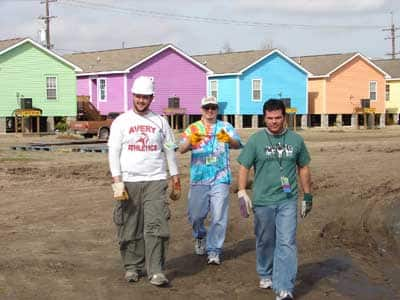 Participation in community action projects is one of the most enjoyable ways for Ben & Jerry’s employees to give back to the community. Over the years, we’ve made a tradition of many of these projects.
Participation in community action projects is one of the most enjoyable ways for Ben & Jerry’s employees to give back to the community. Over the years, we’ve made a tradition of many of these projects.
CAT Team Community Service Day
In our own backyard, we commit one day a year to a Company service project, organized by the Community Action Teams (CATs) at each of our three Company sites. Learn more about the CAT projects we completed in 2007.
Franchise Community Service Project
Our annual Franchise Community Gathering meeting, held in a different location every year, includes a service project with Ben & Jerry’s corporate employees and Scoop Shop owners in the city where we gather. Learn more about our project in New Orleans.
Community Volunteering and Service
Employees at Ben & Jerry’s plants in Waterbury and St. Albans participate in a wide range of community projects as well. In 2007, Waterbury plant employees spent almost 1300 hours in community service and raised over $10,000 to support local nonprofit organizations. Highlights included a Food and Coat Drive to benefit the Waterbury Food Shelf that gathered over 300 pounds of food and about 30 winter coats; participation in the Prouty Challenge to raise money for the Norris Cotton Cancer Center in New Hampshire; and the Great Pumpkin Giveaway.
St. Albans plant employees gave nearly 2,100 hours of time to community service projects and raised over $28,000 to support Vermont nonprofits, including participation in Vermont’s Maple Festival, June Dairy Days, the Franklin County Relay for Life, and the March of Dimes walk.
Our Central Support Office in South Burlington extends a community service benefit to every employee, allowing them to take 40 hours of paid time off to volunteer with a nonprofit organization. Our records indicate that dozens of employees used this benefit in 2007, though we still have not managed to create a system that can automatically track the total hours.
Project Joy
Ben & Jerry’s organizes this project each year around the holidays to reach out to communities in Vermont facing economic hardship. In 2007, our Central Support Office worked with Northeast Kingdom Community Action in St. Johnsbury, Vermont and Home Instead Senior Care in South Burlington. Working from a stack of wish lists, our employees purchased, wrapped, and sent presents and books to 25 children from families in crisis and 11 seniors in assisted living arrangements without families of their own. It’s always a joy for everyone involved!
R&D Christmas Cookie Sale
Ben & Jerry’s Flavor Gurus like to do a little cross-training in the kitchen during the holiday season, so each year they turn their talents to baking some irresistible Christmas cookies and selling them to folks here in the Central Office. In 2007, they donated proceeds from cookie sales — plus a Ben & Jerry’s Foundation match — totaling $875 to the WARMTH program, which funds emergency heating oil supplies for low-income families in Vermont.
CONSUMER SERVICES
CONNECTING WITH CONSUMERS
For years, we’ve known that  folks who love what’s in our ice cream are likely to care just as much about what’s behind it. They read the messaging on our packages, hang out at the Ben & Jerry’s website, dig up our media coverage — for better and for worse — and speak out about how they feel. For this we’re thankful.
folks who love what’s in our ice cream are likely to care just as much about what’s behind it. They read the messaging on our packages, hang out at the Ben & Jerry’s website, dig up our media coverage — for better and for worse — and speak out about how they feel. For this we’re thankful.
We try to hold up our end of the bargain by keeping our Company values front and center in our ongoing dialogue with consumers.
SOCIAL MISSION CAMPAIGNS
Sometimes acting on our values means making some noise about important environmental, social, and political issues and, hopefully, spurring folks to take action. Learn more about our 2007 campaigns.
SOCIAL MISSION FLAVORS
![]() Some of the products we sell have a Social Mission component built in to every bite. Dig in!
Some of the products we sell have a Social Mission component built in to every bite. Dig in!
SHARING OUR STORIES
We strive to communicate about our business with integrity and transparency, and we take every chance we get to talk about our Company values. Check it out.
CONSUMER AFFAIRS
When consumers need to tell us their story — to ask a question, voice a complaint, or give us praise — we believe in listening carefully and answering honestly. Learn more about what we heard.
MARKETING MATERIALS
Our Design Department is committed to using environmentally friendly papers, inks, and other products in the production of Ben & Jerry’s marketing materials.
Social Mission Campaigns
While Ben & Jerry’s has always been a brand built for fun, we do take a number of substantive issues very seriously. Sustainable agriculture; care for our environment; social justice and equality; peace without violence are among them. Learning to stand up for the values we believe in has been a journey. Along the way, we think we’ve made some noise with issue-based campaigns, hopefully motivated action, and maybe even inspired a few solutions.
In 2007, we took on several issues, large and small. Here’s a quick rundown of the roads we followed. Click through to learn more.
No Clones Campaign (US)
 When the U.S. Food and Drug Administration declared that it believed meat and milk from cloned animals was safe to eat, we were beside ourselves, twice over! So we took to the streets to show our disappointment with the FDA’s decision — and to urge Americans to speak out against cloning during the FDA’s 90-day public comment period.
When the U.S. Food and Drug Administration declared that it believed meat and milk from cloned animals was safe to eat, we were beside ourselves, twice over! So we took to the streets to show our disappointment with the FDA’s decision — and to urge Americans to speak out against cloning during the FDA’s 90-day public comment period.
Lick Global Warming (US)
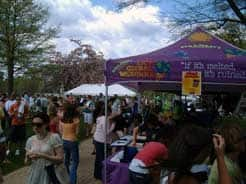 For six years now, we’ve been working to educate the U.S. public about global warming and inspire individual and collective action to address the problem. In 2007, we set out to build grassroots support for aggressive federal legislation to reduce the United States’ production of greenhouse gas emissions.
For six years now, we’ve been working to educate the U.S. public about global warming and inspire individual and collective action to address the problem. In 2007, we set out to build grassroots support for aggressive federal legislation to reduce the United States’ production of greenhouse gas emissions.
Climate Change College (EU)
 Since 2005, we’ve been graduating Ben & Jerry’s Climate Change Ambassadors from this unique program, in collaboration with polar explorer Marc Cornelissen and the World Wildlife Fund. In 2008, our new ambassadors crafted fun and powerful projects to inspire action on climate change.
Since 2005, we’ve been graduating Ben & Jerry’s Climate Change Ambassadors from this unique program, in collaboration with polar explorer Marc Cornelissen and the World Wildlife Fund. In 2008, our new ambassadors crafted fun and powerful projects to inspire action on climate change.
Cool Your Jets (US and EU)
Since 2005, we’ve been graduating Ben & Jerry’s Climate Change Ambassadors from this unique program, in collaboration with polar explorer Marc Cornelissen and the World Wildlife Fund. In 2008, our new ambassadors crafted fun and powerful projects to inspire action on climate change.
Fair Trade Month
 During Fair Trade Month (October), we used our website, our Scoop Shops, and our Fair Trade Certified Coffee ice cream to raise awareness among consumers about how buying Fair Trade ingredients improves the quality of life for farmers in the developing world.
During Fair Trade Month (October), we used our website, our Scoop Shops, and our Fair Trade Certified Coffee ice cream to raise awareness among consumers about how buying Fair Trade ingredients improves the quality of life for farmers in the developing world.
Environmental Action Contest (US)
Inspired by An Inconvenient Truth, Al Gore’s 2006 documentary film on global warming, Ben & Jerry’s kicked off an Environmental Community Action Contest open to every high school student in Vermont in 2007. Two students from Vermont Academy took home the grand prize for their project to develop wind energy.
Save Darfur (US)
One of the great tragedies of our time is the crisis that has gripped the Darfur region of Sudan in the past several years. In 2007, Ben & Jerry’s sponsored a resolution and circulated it among U.S. businesses calling on the world community to use economic sanctions and diplomatic pressure to protect the people of Darfur.
HOLD THE CLONES
In December 2006, when the FDA signaled its intention to approve meat and milk from cloned animals for human consumption, Ben & Jerry’s took to the streets to show our opposition — and to urge Americans to speak  out against cloning during the FDA’s 90-day public comment period.
out against cloning during the FDA’s 90-day public comment period.
On a bitterly cold day in early February 2007, we joined forces with six public interest groups and staged a ‘Truth or Clone-sequences’ demonstration in Washington, D.C. With more than 100 people wearing cow costumes, we marched through the streets of the city carrying signs and shouting slogans such as “Hold the Clones!” “Cloney Baloney” and “Don’t Mess with Bessie!”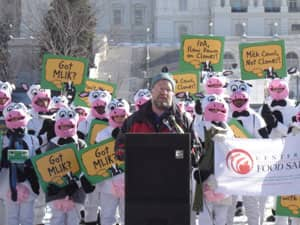
We concluded our demonstration with a press conference on the U.S. Capitol lawn with our partners Food and Water Watch, Center for Food Safety, Consumer Federation of America, Humane Society of the United States, the National Farmers Union, and the Union of Concerned Scientists. Together, these groups represent tens of millions of Americans who, polls show, do not support cloning animals for food.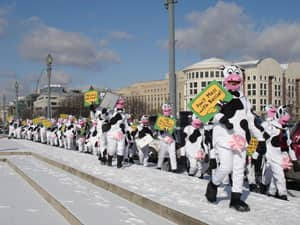
We believe the demonstration was a very effective way to educate and energize the public on the cloning issue. News coverage of the event registered 38 million media impressions across the U.S.
We followed up the D.C. demonstration with an action page on the Ben & Jerry’s website and a Chunkmail message that connected to the FDA’s cloning comment page. The public response to the group campaign was tremendous — the combined effort with our nonprofit partners helped approximately 145,000 people nationwide share their thoughts with the FDA on the cloning issue. The FDA received so many comments, in fact, that they were forced to extend the public comment period by an additional month to accommodate the response.
The FDA was not swayed. On January 15, 2008, the FDA announced its final determination that foods from cloned animals and their progeny are safe for human consumption.
Ben & Jerry’s is committed to working with our suppliers to ensure that the milk and cream that goes into our ice cream does not come from cloned cows or their offspring. As always, we intend to tell consumers exactly what’s in our ice cream and other products, and we are actively working on a way to let consumers know our position on clones on our product packaging.
We will continue to be engaged with Congress and the federal government on this issue to push for a national framework to track cloned animals, which would support the efforts of companies like ours to avoid clones in the supply chain.
LICK GLOBAL WARMING
 2007 marked the sixth year of Ben & Jerry’s Lick Global Warming campaign, a commitment to educate the public about global warming and inspire individual and collective action to address the problem. Our goal in 2007 was to build grassroots support for aggressive federal legislation to reduce the United States’ production of greenhouse gas emissions.
2007 marked the sixth year of Ben & Jerry’s Lick Global Warming campaign, a commitment to educate the public about global warming and inspire individual and collective action to address the problem. Our goal in 2007 was to build grassroots support for aggressive federal legislation to reduce the United States’ production of greenhouse gas emissions.
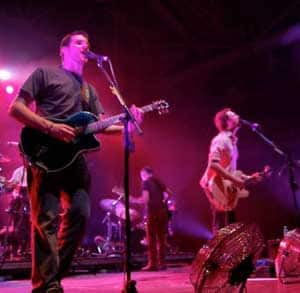 We took this message and plenty of ice cream on the road as a part of the Spring Campus Consciousness Tour organized by the band Guster. This national eco-friendly tour touched down at over 20 colleges and universities, drawing in huge student crowds with Guster’s musical performance and then hitting them over the head with a bevy of social/environmental activist campaigns — or the other way around. The truth is, the tour was a great way to have some fun and spread the word about important issues at the same time.
We took this message and plenty of ice cream on the road as a part of the Spring Campus Consciousness Tour organized by the band Guster. This national eco-friendly tour touched down at over 20 colleges and universities, drawing in huge student crowds with Guster’s musical performance and then hitting them over the head with a bevy of social/environmental activist campaigns — or the other way around. The truth is, the tour was a great way to have some fun and spread the word about important issues at the same time.
 On tour, we scooped over 20,000 samples of Ben & Jerry’s ice cream and gave out 8,000 Lick Global Warming brochures. More importantly, we collected and sent over 5,000 postcards to Congress in support of the Boxer-Sanders Global Warming Pollution Reduction Act, the most aggressive bill yet introduced in Congress designed to address global warming. Another 2,500 people took action through our LickGlobalWarming.org website.
On tour, we scooped over 20,000 samples of Ben & Jerry’s ice cream and gave out 8,000 Lick Global Warming brochures. More importantly, we collected and sent over 5,000 postcards to Congress in support of the Boxer-Sanders Global Warming Pollution Reduction Act, the most aggressive bill yet introduced in Congress designed to address global warming. Another 2,500 people took action through our LickGlobalWarming.org website.
 We reached beyond the Consciousness Tour with a Lick Global Warming advertising campaign on 418 college campuses. With large format ads in high-traffic spots on campus and newspaper ads, we created over 64 million impressions with a message to take action on global warming.
We reached beyond the Consciousness Tour with a Lick Global Warming advertising campaign on 418 college campuses. With large format ads in high-traffic spots on campus and newspaper ads, we created over 64 million impressions with a message to take action on global warming.
Off campus, we supported the Lick Global Warming campaign with signage, position papers and postcards to Congress in Ben & Jerry’s Scoop Shops. We also spruced up our LickGlobalWarming.org website with new, up-to-date information and a fun Eco-Mission game. Altogether, the revised site received a total of 220,000 visitors in 2007.
Finally, we developed a plan with our friends at Patagonia to place a postcard to Congress in support of the Boxer-Sanders Bill — and information on carbon offsets — into 525,000 copies of Patagonia’s July 2007 catalog. In return, Ben & Jerry’s offset the emissions associated with the production and shipment of the catalog through NativeEnergy. We thought it was a creative and environmentally friendly way to get the word out as we keep working to lick global warming.
CLIMATE CHANGE COLLEGE
 Since 2005 Ben & Jerry’s has funded climate change research in the Arctic and made it possible for students aged 18-30 to take part — and give back — through the Ben & Jerry’s Climate Change College. The College is a partnership with polar explorer and environmentalist Marc Cornelissen and environmental NGO, World Wildlife Fund (WWF).
Since 2005 Ben & Jerry’s has funded climate change research in the Arctic and made it possible for students aged 18-30 to take part — and give back — through the Ben & Jerry’s Climate Change College. The College is a partnership with polar explorer and environmentalist Marc Cornelissen and environmental NGO, World Wildlife Fund (WWF).
In 2007 our Ambassadors from the UK, Netherlands, Ireland and Germany travelled to Spitsbergen, in Svalbard in Arctic Norway, using rail travel where possible, and offsetting their air travel through Cool Your Jets. Our Ambassadors got up close and personal with pressing Arctic issues related to climate change such as glacial retreats, endangered polar bear habitats, and the cultural impacts of climate change on local people.
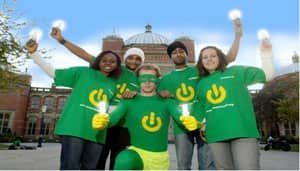 Part of the group also delved deeper into understanding one of the biggest threats in the Arctic, the gradual decline of Arctic sea ice. They joined sea ice specialists Christian Haas from the Alfred Wegener Institute and French explorer Jean-Louis Etienne on the Arctic Ocean itself, close to the geographic North Pole. Learning from the scientists, they helped collect field data to verify airborne radar readings.
Part of the group also delved deeper into understanding one of the biggest threats in the Arctic, the gradual decline of Arctic sea ice. They joined sea ice specialists Christian Haas from the Alfred Wegener Institute and French explorer Jean-Louis Etienne on the Arctic Ocean itself, close to the geographic North Pole. Learning from the scientists, they helped collect field data to verify airborne radar readings.
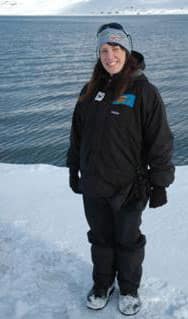 Back in their home countries, Ambassadors were challenged to respond to their privileged experience by creating a ‘climate change solutions’ project that reduced CO2, saved money and educated their peers. Graduate Neil Jenning’s StudentSwitchOff campaign, for example has saved over £28,000 in energy bills and 138 tonnes of CO2 at university campuses across the UK. Irish candidate Lesley Butler set up Eco-Biz, an environmental consultancy company that helps small and medium enterprises reduce their carbon footprint. Lars de Keijser from the Netherlands set up Cool Schools, an innovative fundraising initiative, that sees schoolchildren raise funds for eco-improvements at school through sales of energy efficient consumer items in the local community.
Back in their home countries, Ambassadors were challenged to respond to their privileged experience by creating a ‘climate change solutions’ project that reduced CO2, saved money and educated their peers. Graduate Neil Jenning’s StudentSwitchOff campaign, for example has saved over £28,000 in energy bills and 138 tonnes of CO2 at university campuses across the UK. Irish candidate Lesley Butler set up Eco-Biz, an environmental consultancy company that helps small and medium enterprises reduce their carbon footprint. Lars de Keijser from the Netherlands set up Cool Schools, an innovative fundraising initiative, that sees schoolchildren raise funds for eco-improvements at school through sales of energy efficient consumer items in the local community.
In 2008, the campaign will broaden again to include Spain, France, Sweden, and Portugal. For more information on other successful alumni visit www.climatechangecollege.org
COOL YOUR JETS
Since 2002, Ben & Jerry’s has been educating people around the world about the challenge of global warming through our Lick Global Warming Campaign. We’ve also been investing in carbon offsets to reduce our company’s contribution to global warming.
In 2006, we brought these two great ideas together through our Cool Your Jets program. Together with our friends at NativeEnergy in the U.S. and myclimate in Europe, we provided an easy, online way for people to “cool  their jets” by purchasing carbon offsets to counter the greenhouse gas emissions from their airplane travel.
their jets” by purchasing carbon offsets to counter the greenhouse gas emissions from their airplane travel.
We were pleased with the initial response to our Cool Your Jets site, spurred on by partnerships with REI and Lonely Planet. We even expanded the site to allow the purchase of offsets for car travel. But in 2007, without an active campaign to drive people to the site, we saw very little traffic and few people chose to purchase offsets through Cool Your Jets.  We are reviewing our plans for the future of the program, as there are now many ways for consumers to purchase carbon offsets — and an ice cream company may not be the first place folks look when they want to mitigate their climate impacts.
We are reviewing our plans for the future of the program, as there are now many ways for consumers to purchase carbon offsets — and an ice cream company may not be the first place folks look when they want to mitigate their climate impacts.
We continue to believe offsets are an important tool in the fight against global warming. They provide an effective and inexpensive way to neutralize the carbon generated from air travel and the consumption of fossil fuels — by providing the funding for new cleaner, greener energy projects that rely on wind, solar and other renewable energy sources.
FAIR TRADE MONTH
In October 2007, Ben & Jerry’s once again joined our partners at Transfair USA to celebrate Fair Trade Month with a national program designed to generate awareness of  Fair Trade Certified products.
Fair Trade Certified products.
We sent a Chunkmail message to our die-hard fans and created messaging for Ben & Jerry’s Scoop Shops to drive traffic to a dedicated Fair Trade page on our website. About 4,000 people found their way to the site. Once there, visitors could learn more about the Fair Trade movement, Transfair USA, and Ben & Jerry’s Fair Trade purchasing.
Ben & Jerry’s believes that Fair Trade certification is an important way to insure that our purchasing is making a positive impact in producing areas of developing countries. By guaranteeing farmers higher prices for their harvests, Fair Trade certification enables farmers to reinvest in their land and their communities.
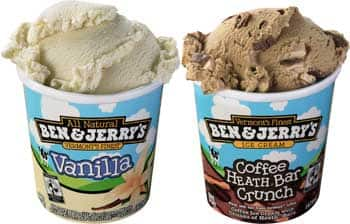 We are excited to be increasing our company’s Fair Trade purchasing in 2007, and we’re pleased to help spread the word about this growing movement.
We are excited to be increasing our company’s Fair Trade purchasing in 2007, and we’re pleased to help spread the word about this growing movement.
ENVIRONMENTAL COMMUNITY ACTION
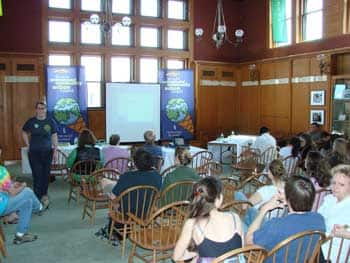 Inspired by An Inconvenient Truth, Al Gore’s 2006 documentary film on global warming, Ben & Jerry’s kicked off an Environmental Community Action Contest open to every high school student in Vermont in 2007. We asked students to send us their plan to “Green Up Vermont” and help slow global warming. Over 40 students submitted proposals and four finalists were chosen to present their plans at a special Ben & Jerry’s event on Earth Day at the University of Vermont.
Inspired by An Inconvenient Truth, Al Gore’s 2006 documentary film on global warming, Ben & Jerry’s kicked off an Environmental Community Action Contest open to every high school student in Vermont in 2007. We asked students to send us their plan to “Green Up Vermont” and help slow global warming. Over 40 students submitted proposals and four finalists were chosen to present their plans at a special Ben & Jerry’s event on Earth Day at the University of Vermont.
Two students from Vermont Academy, Rachel and Savannah, took home the grand prize of $2,000 for their proposal to construct a wind turbine on their school campus  and to educate their community about the potential of wind energy. They are currently lining up additional funding and permitting to make their project a reality. To learn more about the project, watch the video Savannah and Rachel made for The Alliance for Climate Protection.
and to educate their community about the potential of wind energy. They are currently lining up additional funding and permitting to make their project a reality. To learn more about the project, watch the video Savannah and Rachel made for The Alliance for Climate Protection.
Runners-up included Springfield High School, Mt. Anthony High School, and Middlebury High School. Each received $500 grants to move forward on implementing their climate change action plans. In addition, all finalists received a year’s supply of ice cream, a signed copy of the book, An Inconvenient Truth, and a Ben & Jerry’s ice cream party for their school.
Our thanks to all the students who participated!
BEN & JERRY’S SHARES an OLYMPIC DREAM in DARFUR
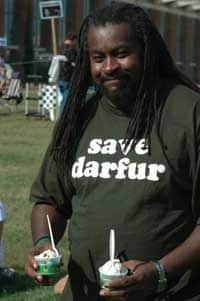 One of the great tragedies of our time is the crisis that has gripped the Darfur region of Sudan in the past several years. Millions of people have been uprooted and displaced and violence has claimed the lives of hundreds of thousands more.
One of the great tragedies of our time is the crisis that has gripped the Darfur region of Sudan in the past several years. Millions of people have been uprooted and displaced and violence has claimed the lives of hundreds of thousands more.
Even though it’s far afield from the work of our Company, Ben & Jerry’s believes that in this time of extreme emergency, every effort must be made to help the people of Darfur and to protect them from further violence.
In 2007, we sponsored a resolution and circulated it among U.S. businesses calling on the world community to use economic sanctions and diplomatic pressure to protect the people of Darfur. Read the statement below.
We also provided support in the fall of 2007 for a symbolic Olympic Torch Run organized by the Save Darfur Coalition, Dream for Darfur, and STAND 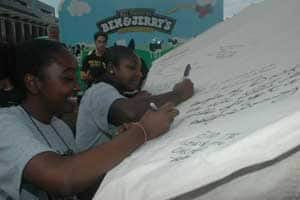 (A Student Anti-Genocide Coalition). Over several weeks, this relay visited 25 U.S. cities to raise awareness about the humanitarian crisis in Darfur.
(A Student Anti-Genocide Coalition). Over several weeks, this relay visited 25 U.S. cities to raise awareness about the humanitarian crisis in Darfur.
When the torch came to Burlington on September 20, we scooped free ice cream and handed out our own position papers on the Darfur crisis. We also showed up to hand out ice cream at torch run stops that attracted about 500 people each in Philadelphia and Chicago.
Ben & Jerry’s also promoted the torch relay on our website, highlighting the schedule of stops and action opportunities through www.dreamfordarfur.org.

The Edible Social Mission
Most of the time, our Company’s Social Mission is a guide to the way we operate our business. Sometimes, though, when we’re open to the inspiration, our Company values can lead us to fantastic product ideas, too. Or we may just see an irresistible link between a flavor and a cause, and, well, we can’t resist. These Social Mission flavors give us the best of both worlds at the same time — theory and practice in perfect alignment.
Royalties
Sharing ice cream is an unqualified good thing, and so is sharing some of the money we make on sales of our ice cream with groups out to make a difference. In 2007, the following flavors of Ben & Jerry’s produced royalties to support causes closely aligned with our values.
New in 2007 — Stephen Colbert’s AmeriCone Dream™ (US)
![]() The first flavor to break into the Ben & Jerry’s top 10 in 9 years, Stephen Colbert’s AmeriCone Dream™ isn’t just another pretty pint. This flavor pays a royalty to The Stephen Colbert AmeriCone Dream Fund, which supports charities active in areas of concern to Mr. Colbert such as providing food and medical assistance for disadvantaged children, helping veterans and their families, and supporting environmental causes. Total royalties in 2007 reached $138,175.
The first flavor to break into the Ben & Jerry’s top 10 in 9 years, Stephen Colbert’s AmeriCone Dream™ isn’t just another pretty pint. This flavor pays a royalty to The Stephen Colbert AmeriCone Dream Fund, which supports charities active in areas of concern to Mr. Colbert such as providing food and medical assistance for disadvantaged children, helping veterans and their families, and supporting environmental causes. Total royalties in 2007 reached $138,175.
New in 2007 — Willie Nelson’s Country Peach Cobbler™ (US)
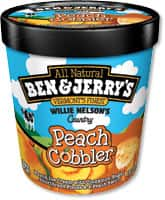 With a long track record of activism on behalf of family farms, Willie Nelson was the perfect choice to join The Grateful Dead, Phish, and The Dave Matthews Band on the roster of Ben & Jerry’s partners who combine music with a social conscience. A royalty from the sale of this flavor is donated to Farm Aid, whose mission is to build a vibrant family-farm centered system of agriculture in America. Royalties in 2007 totaled $85,345.
With a long track record of activism on behalf of family farms, Willie Nelson was the perfect choice to join The Grateful Dead, Phish, and The Dave Matthews Band on the roster of Ben & Jerry’s partners who combine music with a social conscience. A royalty from the sale of this flavor is donated to Farm Aid, whose mission is to build a vibrant family-farm centered system of agriculture in America. Royalties in 2007 totaled $85,345.
Phish Food® (US)
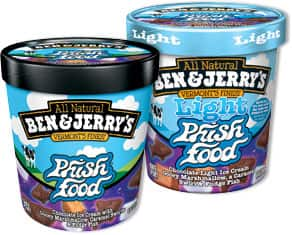 Although legendary Vermont band Phish played their last concert in 2004, their unquenchable energy lives on through Ben & Jerry’s Phish Food® original and light ice creams. These flavors pay a royalty to the Waterwheel Foundation which is dedicated to the protection and preservation of Lake Champlain and its watershed. In 2007, royalties totaled $238,441.
Although legendary Vermont band Phish played their last concert in 2004, their unquenchable energy lives on through Ben & Jerry’s Phish Food® original and light ice creams. These flavors pay a royalty to the Waterwheel Foundation which is dedicated to the protection and preservation of Lake Champlain and its watershed. In 2007, royalties totaled $238,441.
Dave Matthews Band’s Magic Brownies™ (US)
As the main course in our ongoing 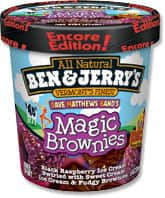 Lick Global Warming campaign, Dave Matthews Band’s Magic Brownies™ combines the spirit of Dave Matthews Band, the razzle of chocolate and raspberries, and the conscience of Mother Earth in one place. A portion of every sale of Dave Matthews Band’s Magic Brownies™ goes to Dave Matthews Band’s Bama Works Fund to support the work of nonprofit groups taking action against global warming. In 2007, this flavor produced royalties of $35,471 for Bama Works.
Lick Global Warming campaign, Dave Matthews Band’s Magic Brownies™ combines the spirit of Dave Matthews Band, the razzle of chocolate and raspberries, and the conscience of Mother Earth in one place. A portion of every sale of Dave Matthews Band’s Magic Brownies™ goes to Dave Matthews Band’s Bama Works Fund to support the work of nonprofit groups taking action against global warming. In 2007, this flavor produced royalties of $35,471 for Bama Works.
Butter Pecan (US)
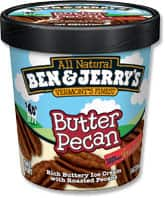 Continuing a relationship we’ve had for many years, sales of our Butter Pecan ice cream paid out royalties of $58,654 to the Tom Joyner Foundation in 2007. Tom Joyner hosts a top-rated, nationally syndicated morning radio show targeting the African American community that airs in dozens of states. The Tom Joyner Foundation is a nonprofit foundation that provides assistance to students at Historically Black Colleges and Universities.
Continuing a relationship we’ve had for many years, sales of our Butter Pecan ice cream paid out royalties of $58,654 to the Tom Joyner Foundation in 2007. Tom Joyner hosts a top-rated, nationally syndicated morning radio show targeting the African American community that airs in dozens of states. The Tom Joyner Foundation is a nonprofit foundation that provides assistance to students at Historically Black Colleges and Universities.
Baked Alaska — (Europe)
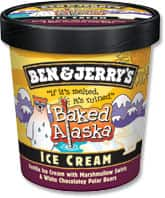 Legend has it that when the United States acquired Alaska they invented the dessert now known as ‘Baked Alaska,’ an ice cream cake topped with meringue and baked briefly in the oven. Now, a century later, Alaska itself is baking as global warming threatens Arctic environments. Ben & Jerry’s Baked Alaska flavor — sold in European markets — uses vanilla ice cream, marshmallow swirls, and white chocolate Polar Bears to put the spotlight on this predicament. Even better, we direct a portion of the sales of this flavor to support Ben & Jerry’s Climate Change College where young people learn how to become climate change activists.
Legend has it that when the United States acquired Alaska they invented the dessert now known as ‘Baked Alaska,’ an ice cream cake topped with meringue and baked briefly in the oven. Now, a century later, Alaska itself is baking as global warming threatens Arctic environments. Ben & Jerry’s Baked Alaska flavor — sold in European markets — uses vanilla ice cream, marshmallow swirls, and white chocolate Polar Bears to put the spotlight on this predicament. Even better, we direct a portion of the sales of this flavor to support Ben & Jerry’s Climate Change College where young people learn how to become climate change activists.
Peace of Cake (EU — The Netherlands)
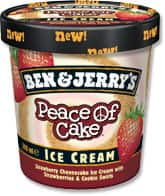 If you know Ben & Jerry’s, you know that we care as much about world peace as we do about our ice cream flavours. That’s the reason we support the War Child Foundation, which works to rehabilitate child soldiers in war-torn countries. Ben & Jerry’s donates 25 eurocents to Warchild from the sale of every pint of Peace of Cake that we sell in the Netherlands.
If you know Ben & Jerry’s, you know that we care as much about world peace as we do about our ice cream flavours. That’s the reason we support the War Child Foundation, which works to rehabilitate child soldiers in war-torn countries. Ben & Jerry’s donates 25 eurocents to Warchild from the sale of every pint of Peace of Cake that we sell in the Netherlands.
Bohemian Raspberry (UK)
 Thanks to the fans who suggested the name, and Queen who proclaimed it cool, Bohemian Raspberry is a delicious addition to our historic honour roll of rock-legendairy concoctions. And to make this flavour even more worth doing the fandango, 10 p (or 15 cents €) of the purchase price goes to the Mercury Phoenix Trust, the charity set up in Freddy Mercury’s memory.
Thanks to the fans who suggested the name, and Queen who proclaimed it cool, Bohemian Raspberry is a delicious addition to our historic honour roll of rock-legendairy concoctions. And to make this flavour even more worth doing the fandango, 10 p (or 15 cents €) of the purchase price goes to the Mercury Phoenix Trust, the charity set up in Freddy Mercury’s memory.
Discontinued in 2007
Milkshakes
In 2006, Ben & Jerry’s introduced a line of bottled milkshakes marketed under a multi-year licensing agreement with the PepsiCo Company. In line with our brand values, we dedicated a portion of the proceeds 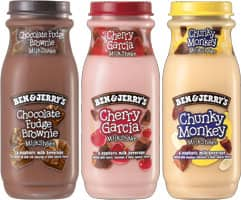 from these milkshakes to the purchase of carbon offsets through Clean Air, Cool Planet, an organization that provides funding for the construction of new renewable energy projects in the United States.
from these milkshakes to the purchase of carbon offsets through Clean Air, Cool Planet, an organization that provides funding for the construction of new renewable energy projects in the United States.
Retailer acceptance — and sales — of the milkshakes were disappointing and we made the decision to discontinue these products in 2007. As the milkshakes disappear, so will the associated contribution to Clean Air, Cool Planet, we’re sorry to say. But we’ll keep looking to explore other product ideas outside of traditional ice cream — and we’ll also keep looking for ways to support the growth of renewable energy.
Shouting it Out
The role of Public Relations at Ben & Jerry’s is to represent our Company in a transparent and honest way, while trying to maximize the exposure for our values-based, social mission-focused actions.
Ben & Jerry’s had another banner year in 2007, jam-packed with all manner of media coverage for ice cream-related mayhem around the world. Our social mission led us to a protest, we shined on T.V. with a new celebrity partner, and our flavors were funky and true!
Kicking off the year, the spotlight shone upon us in Washington, DC as we protested against cloned foods becoming a part of the U.S. food supply in January of 2007. With more than 100 people in cow suits dancing through the streets of the city, we drew media attention that landed us coverage nationally and in over 100 local markets as well as through online channels. In all, the event drew millions of viewers and readers to be more aware of this important issue.
On the tube, Co-Founder Jerry Greenfield made smoothies with our human-powered bike blender on the Today Show in May to highlight our Global Warming efforts. Shortly after that, a second segment on the Today Show featured a correspondent following Ben & Jerry’s ice cream process from flavor development, to manufacturing on the line at our Waterbury plant, to finally sampling a custom made flavor called “Where In the Whirled,” after the segment “Where In the World Is Matt Lauer?” Switching channels to the Food Network, Flavor Guru John Shaffer appeared on “Paula’s Party,” the Emmy award-winning Paula Deen show. Paula featured two custom-made flavors created by Shaffer exclusively for her show.
Ben & Jerry’s whipped up two new flavors in 2007, Stephen Colbert’s AmeriCone Dream and Willie Nelson’s Country Peach Cobbler, which became instant hits, in part thanks to the excellent PR that these celebs whipped up for us. Colbert’s flavor, which he shamelessly but hilariously pitched on his nightly show, “The Colbert Report” on Comedy Central, even captured the number one flavor spot for a while, dethroning Cherry Garcia after a long, uninterrupted reign. In one of our favorite moments of the year, Colbert even invited Nelson onto his show for a flavor taste-off, which was skillfully mediated by US diplomat Richard Holbrooke. The competition fell apart when Colbert refused to even taste Nelson’s Peach Cobbler — on the grounds that he had given ice cream up for Lent. Predictably, Colbert declared his own flavor the winner anyway.
As always, Free Cone Day in April was a big attention grabber. By our count, stories about Ben & Jerry’s giving away ice cream generated as many stories as the release of our celebrity flavors. While some stories were just about ice cream, many also took the time to point out that Free Cone Day also benefits hundreds of nonprofit organizations around the country.
The low point of our PR year came with the publication of a Newsweek story in December about a Ben & Jerry’s franchisee who felt he had not been treated fairly by the Company. We disagreed strongly with the article, feeling the story wasn’t an accurate or balanced representation of our business practices. For the most part, the public wasn’t convinced by the story either, and the story didn’t echo much beyond the initial article.
On the up side, Advertising Age’s Eco-Marketer of the Year award for the packaged goods category went to Ben & Jerry’s in 2007 for our ongoing “Lick Global Warming” campaign and overall environmental efforts. Alloy Marketing also awarded Ben & Jerry’s with a # 1 pick by college-aged students as the leaders in socially responsible business. We’re always grateful to receive praise for the work we’re doing, and it provides great motivation to keep going!
What Our Consumers Tell Us
At Ben & Jerry’s, social and environmental values are integral to our business, so we encourage our fans to share their thoughts with us on just about any topic. Many do. And it’s clear that our fans hold us to the high standards we have set for ourselves across all three parts of our Mission Statement, heightening their euphoria when we meet or exceed their expectations and intensifying their disappointment when we let them down. The opportunity that this gives the consumer services team for personal interaction with our customers and for capturing both qualitative and quantitative data is invaluable. The process is dynamic and ongoing: We learn how to be careful listeners, we find out whether people think we’ve fallen short or gotten things right, and we always make an honest effort to explain where we’re coming from.
Messages from 2007
As we always do, we heard from a lot of people in 2007. In all, more than 20,000 people took the time to contact us about our company’s products, practices and social mission activities last year. Even so, this number was down significantly from 2006, when we had 60,000 contacts, many urging us to begin sourcing eggs from cage-free chickens. We did commit to phasing in eggs from cage-free hens, and we received numerous compliments on that decision from very grateful customers in 2007. This led the way to an increase in contacts praising the company’s Social Mission. On the other hand, we heard from fewer people offering praise for our environmental practices and products.
The preferred method of contact was via e-mail, up 3% over last year, followed by phone calls which increased by 12% and letters which decreased 12 %.
The good news on the product side is that we received many fewer complaints about add-ins (the chocolate chunks, cookie dough, etc. in our ice cream) as regards their texture, flavor and other miscellaneous problems. Most of the product quality complaints we heard had to do with product labeling, flavor issues, or underfilled pints.
Other concerns voiced by consumers, but less frequently, related to temperature abuse (which adversely affects ice cream texture), complaints about an experience in a Ben & Jerry’s scoop shop, or nutritional inquiries. Scoop shop complaints rose slightly. Requests for nutritional information saw a large increase and focused on questions related to trans fats, stabilizers, corn syrup, pasteurization and homogenization.
PRAISE
Product
We think it is fair to say that the 11% decrease in contacts does not point to any lack of interest on the part of consumers in our product. Rather, the data often reflect interest that is generated either externally or internally. The blip in phone calls about cage-free hen eggs is a good example of the former, while excitement about flavor tributes such as Stephen Colbert’s Americone Dream™ is a choice an example of the latter.
Environment
The main source of interest in our environmental activities came from students doing research projects. We’re pleased to be able to provide in-depth information to our consumers on our drive to be at the cutting edge of efforts to reduce the environmental impact of all of our activities.
Social Mission
The majority of social mission contacts praised our commitment to the company mission. Praise was up 14% with animal rights comments leading the way, specifically positive feedback on the company’s decision to begin sourcing eggs from cage-free hens. It was a pleasure to hear some really happy consumers expressing their loyalty to the brand. Other areas of interest included our stand on rBGH, our use of Fair Trade™ ingredients and our protest of the FDA approval of cloned food in the American food supply.
COMPLAINTS
Package Labeling
There was a 160% increase in this category in 2007 due to an unfortunate ingredient listing error on a new flavor of ice cream. The word “wheat” did not appear on the first run of the packaging on the Willie Nelson’s Country Peach Cobbler ice cream. The mistake was discovered quickly and corrected. Our consumers let us know how much they appreciated our efforts to get that information out to the general public, efforts which received invaluable assistance from support organizations such as the Food Allergy Network and the Celiac Sprue Association USA. The large increase in contacts was the direct result of our offer of a replacement coupon.
Packaging Fill (air pocket void)
There was a 20% increase in contacts regarding pints of Ben & Jerry’s ice cream that contained a void, or air pocket, usually near the top or bottom of the container. Our pint cartons are filled according to volume, which can result in a minor void in either end of the carton. Having this data allows us to check our systems to be sure that our consumers are receiving a properly filled container.
Product Flavor
Complaints increased by 16%, with Cherry Garcia flavor complaints leading the category. Complaints ranged from too few or too many add-ins (inclusions), not enough or lack of intensity of flavor (which sometimes can be the direct result of mishandling during transportation or storage). Other contacts involved the consumer not caring for a particular flavor of ice cream, frozen yogurt or sorbet.
Worth the Paper It’s Printed On
Our Design Department is committed to using environmentally friendly papers, inks, and other products in the production of Ben & Jerry’s marketing materials.
Since Design is often the last team to “touch” a project, timelines tend to be on a very fast track. In the past, we were heavy users of overnight shipping and couriers to deliver artwork files, which are frequently too big to send via email. Today, we strongly encourage our vendors and designers to use FTP — file transfer protocol — sites to transfer electronic design files. We are saving time, money, and of course, fuel.
All of the papers we use are process chlorine free (PCF) with high post consumer recycled content, and they are printed using soy based ink whenever possible. In addition, we pay careful attention to the recycled content in the substrates that we use for other printed materials such as banners, signage and point of sale items.
In order to reduce costs and to streamline processing, we moved virtually all of our scoop shop promotional printing to a national print/fulfillment house in 2007. This represents a significant change from previous years, when approximately 90% of our print vendors were Vermont-based. The change won’t affect our commitment to finding earth-friendly solutions to our print/production needs.
COUNTRY CAPSULES
A Global Mission
We don’t have the space or time to tell you everything about how our Company is acting on our Social Mission around the world, but here’s a sampling. Feel free to visit Ben & Jerry’s global websites for more about our activities in specific countries.
Belgium
In 2007 we had a successful Free Cone Day in Belgium, giving away a total of 15,000 free scoops to happy fans from several of our scoop shops and collecting a big donation to nonprofit group ‘Moeders voor Moeders’ (Mothers for Mothers). This partner works to empower underprivileged parents to educate their children and optimize their own life skills and opportunities.
We forged a partnership with a local bus company to help them launch their climate-neutral buses with free ice cream.
France
 Ben & Jerry’s deepened its partnership with Réseau Cocagne, an NGO with a mission to help the chronically unemployed get back into the workforce by building and tending gardens throughout the country. With a donation of €25,000 in 2007, we helped Réseau Cocagne develop new gardens in new communities across the country.
Ben & Jerry’s deepened its partnership with Réseau Cocagne, an NGO with a mission to help the chronically unemployed get back into the workforce by building and tending gardens throughout the country. With a donation of €25,000 in 2007, we helped Réseau Cocagne develop new gardens in new communities across the country.
We helped to raise consumer awareness about the issue of trade justice by sampling our new Fairtrade flavours, Chunky Monkey and Vanilla Toffee Crunch as a part of Sustainable Development Week, Fairtrade Fortnight and other events. We also helped make our major retail customers more aware of Fairtrade Certification in the hopes that they’ll help to build the movement.
 We partnered with newspaper “Metro” to reach more than 2 million readers with messaging about climate change, while we reached over 2,500 French university students directly in recruiting for Ben & Jerry’s Climate Change College.
We partnered with newspaper “Metro” to reach more than 2 million readers with messaging about climate change, while we reached over 2,500 French university students directly in recruiting for Ben & Jerry’s Climate Change College.
We had some fun with a “Woody for President” campaign during the 2007 French national election, encouraging our fans to get out and vote. The campaign helped to double the traffic on the French Ben & Jerry’s website, too.
The United Kingdom
Year two of Ben & Jerry’s Climate Change College brought with it two amazing UK ambassadors, Rob Bell and Neil Jennings. Neil’s campaign delivered a particularly impressive set of results with partner My Climate. His campaign, called ‘The Student Switch Off’, encouraged university students based in different residence halls to compete against each  to reduce energy consumption, offering them prize incentives. By the end of the year, the University of East Anglia alone had saved 100 tonnes of CO2 and £35,000 in energy bills, with the students having a lot of fun in the process. Neil probably had the most fun, making regular appearances around the country dressed in his green Eco Power Ranger lycra suit, attracting lots of media attention and landing himself a profile in the Saturday Telegraph magazine. Forty-one stories that mentioned Ben & Jerry’s Climate Change College appeared in the UK media.
to reduce energy consumption, offering them prize incentives. By the end of the year, the University of East Anglia alone had saved 100 tonnes of CO2 and £35,000 in energy bills, with the students having a lot of fun in the process. Neil probably had the most fun, making regular appearances around the country dressed in his green Eco Power Ranger lycra suit, attracting lots of media attention and landing himself a profile in the Saturday Telegraph magazine. Forty-one stories that mentioned Ben & Jerry’s Climate Change College appeared in the UK media.
We also launched new flavour Bohemian Raspberry, inspired by two of our fans who suggested the name. 10p from every tub sold was donated to the Mercury Phoenix Trust, a foundation set up in Freddie Mercury’s memory to raise awareness for AIDS. Donations to the foundation in 2007 amounted to over £70,000. ROCK ON!
Free Cone Day 2007 was, once again, plenty of fun, with 55 UK sites participating and raising a total of £2,000 for nominated charities at each site. In all, we gave away 18,000 scoops of ice cream.
Our nearly-legendary Sundae Festival took place for the 3rd year on Clapham Common. We saw a record breaking 20,000 punters come through the gates and they licked up 58,000 free scoops of ice cream! With the event’s increasing popularity, we also decided to address the eco-hoofprint of the event to make it a ‘carbon neutral’ affair. We gave out our moooth-watering ice cream in cones instead of tubs — saving nearly 8 tons of CO2 from last year’s festivities alone. We made our cowprint picnic rugs from recycled polyester this year and used green fuel (100% recycled vegetable oil) in biodiesel generators to power the entire festival. Only one ‘minor’ oily hiccup happened — during the headline act on the first day of the festival!
Each year we’ve also contributed the proceeds of our Sundae Festival ticket sales to a local community project. In 2007 we invested our earnings in a solar panel project in India with partners My Climate. Proceeds from ticket sales generated enough funds to construct 175 solar greenhouses in the remote Himalayan mountains which means that people there can now grow more vegetables locally. This created an emission reduction of 1,230 tonnes of CO2 in the atmosphere, benefiting approximately 180 farmer families by providing them with an alternative energy source.
The Netherlands
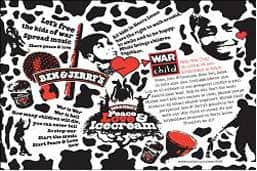 In 2007, Ben & Jerry’s marked the ten-year anniversary of our partnership with NGO War Child, which works to rehabilitate child soldiers in war-torn countries.
In 2007, Ben & Jerry’s marked the ten-year anniversary of our partnership with NGO War Child, which works to rehabilitate child soldiers in war-torn countries.
We donated 25 Eurocents to War Child for every pint of ‘Peace of Strawberry Cheesecake’ we sold in the Netherlands, amounting to €39,099 in all.
 We continued with our Peace-fridge initiative, in which other Dutch businesses could rent a Ben & Jerry’s freezer for €1,000 for two weeks, filled to the brim with Ben & Jerry’s ice cream to share with employees and visitors. Altogether, this project raised an additional €19,000 to support War Child.
We continued with our Peace-fridge initiative, in which other Dutch businesses could rent a Ben & Jerry’s freezer for €1,000 for two weeks, filled to the brim with Ben & Jerry’s ice cream to share with employees and visitors. Altogether, this project raised an additional €19,000 to support War Child.
We continued to spread the word about the important work War Child is doing at 20 Ben & Jerry’s Peace, Love, and Ice Cream events and our own Pop-Up Shop in a high traffic location.  We sampled over 75,000 scoops of ice cream and War Child found more than 1,000 new friends.
We sampled over 75,000 scoops of ice cream and War Child found more than 1,000 new friends.
Dutch Climate Change College ambassadors Lars and Anne made a big splash in their bids to make the world a little bit more sustainable. Anne’s goal was to install 10,000 water saving shower heads in student dormitory rooms. Anne worked for 6 months with University officials, secured all the showerheads and created a pretty snazzy demonstration shower unit to show the showerheads in action. But one week before her campaign the University she’d been working with suddenly realised they’d already converted the shower heads and didn’t require her help and resources anymore. The good news was that the University was saving on water, but the bad news was that Anne didn’t get the chance to reveal her clever campaign. Anne also represented the Climate Change College on MTV’s Live Earth broadcast.
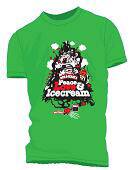 Lars entered the ‘green zone’ with his ‘Cool Schools’ campaign in which he advised schools on how to make their way of education more sustainable. After the education round, which was done by Lars himself, the children took part in a door-to-door campaign, selling energy-efficient light bulbs as well as water-saving shower heads. The profits from the products sold were re-invested directly into energy efficiency and further energy education in the participating schools. Altogether 1,304 energy-efficient light bulbs and 78 shower heads were sold, creating CO2 reductions of 31,296 kg per year. Cool Schools succeeded in selling goods to 1.4% of the target population and spreading the word about energy efficiency to an even broader audience. Lars also received some great media attention for his campaign and had a lot of fun along the way!
Lars entered the ‘green zone’ with his ‘Cool Schools’ campaign in which he advised schools on how to make their way of education more sustainable. After the education round, which was done by Lars himself, the children took part in a door-to-door campaign, selling energy-efficient light bulbs as well as water-saving shower heads. The profits from the products sold were re-invested directly into energy efficiency and further energy education in the participating schools. Altogether 1,304 energy-efficient light bulbs and 78 shower heads were sold, creating CO2 reductions of 31,296 kg per year. Cool Schools succeeded in selling goods to 1.4% of the target population and spreading the word about energy efficiency to an even broader audience. Lars also received some great media attention for his campaign and had a lot of fun along the way!
Ireland
 In 2007, Ireland took part in the Climate Change College for the first time. Lesley Butler was our Irish Ambassador, and she created a campaign called Ecobiz to enlist small and medium businesses to reduce their carbon footprint. Lesley worked with some 20 businesses and made significant progress helping them reduce their emissions. In addition, Lesley drew local, regional, and national media attention, even appearing on prime time television in Ireland and in a photograph in Times Square in New York City.
In 2007, Ireland took part in the Climate Change College for the first time. Lesley Butler was our Irish Ambassador, and she created a campaign called Ecobiz to enlist small and medium businesses to reduce their carbon footprint. Lesley worked with some 20 businesses and made significant progress helping them reduce their emissions. In addition, Lesley drew local, regional, and national media attention, even appearing on prime time television in Ireland and in a photograph in Times Square in New York City.
We had a lot of fun with our recruitment campaign for the next Climate Change ambassador, with the help of company co-founder Jerry Greenfield. We chose Cara Augustenborg who is planning a campaign to help Irish homeowners to lower their carbon footprint when they complete Do-It-Yourself remodeling projects.
 We launched our first Fairtrade ice creams in Ireland in 2007: Vanilla FT and Vanilla Toffee Crunch. The launch gave a boost to public awareness of Fairtrade — and sales of Ben & Jerry’s.
We launched our first Fairtrade ice creams in Ireland in 2007: Vanilla FT and Vanilla Toffee Crunch. The launch gave a boost to public awareness of Fairtrade — and sales of Ben & Jerry’s.
Germany
We celebrated Free Cone Day 2007 in 12 scoop shops across Germany, scooping 16,400 scoops to thank our customers for their support in the previous year and collecting €2,000 for local NGO partners. In Cologne, for example, we supported “Wir für Pänz” an organisation that takes care of disadvantaged children.
In May we started a college Tour with our Climate Change Ambassador Julian v. Blücher. We visited 13 Universities in 15 days, promoting his project to use University building rooftops to generate solar electricity, and to raise awareness of climate change. Julian’s efforts so far have brought five Universities on board to install solar panels and save tons of CO2.
Around Christmas time, we started a “Let’s build a snowman” game on our Ben & Jerry’s website. Visitors could send an e-card to a friend in the form of a snowball, with a €1 donation for each snowball going to Nordlicht, an NGO that helps children develop self-confidence. In total 2,400 e-snowball e-cards were sent, raising €2,400.
Spain
Again in 2007, we continued our Blood Donation Campaign in Spain with great success.
We put new energy into supporting our franchisees’ commitment to Ben & Jerry’s Social Mission in 2007. On Free Cone Day, we served more than 70,000 scoops and almost all of our franchisees partnered with a local non-profit organization to raise awareness and funds totalling over €2,000.
To celebrate Christmas, we collaborated with Cruz Roja Juventud on a sweet campaign to gather toys for underprivileged children. We also gave out Christmas postcards carrying a Social Mission message.
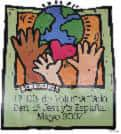 Our partners this year have been:
Our partners this year have been:
- INOUT, a youth hostel working with mentally challenged youth. Ben & Jerry’s raised €3,000 towards the construction of a new hostel wing.
- Fundación Theodora, a nonprofit organization that makes weekly visits with Doctores Sonrisas (Smile Doctors) to cheer up hospitalized children. Many sick children had happy and funny moments thanks to Ben & Jerry’s €3,000 donation this year.
-
Acció Natura, a progressive environmental organization. Our €3,000 donation helped efforts to fight climate change. In return, Acció Natura advised our scoop shops on ways to reduce their environmental impacts.
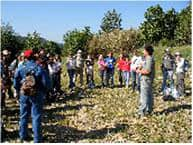 The Ben & Jerry’s team also participated in a fun community service day where we planted trees.
The Ben & Jerry’s team also participated in a fun community service day where we planted trees.
Denmark
 Denmark joined Ben & Jerry’s Climate Change College this year! Our recruitment and information campaign toured the country for 2 weeks, informing students and youngsters about solutions to this global crisis.
Denmark joined Ben & Jerry’s Climate Change College this year! Our recruitment and information campaign toured the country for 2 weeks, informing students and youngsters about solutions to this global crisis.
In 2007, we continued our work with Save the Children, a Danish organization dedicated to improving the physical and social environment for children. Our Ben & Jerry’s scoop shop raised donations through various events and everyday collections for the organisation, collecting more than €2500 in all.
We contributed 3 Ben & Jerry’s freezers packed with ice cream to an online charity auction directed towards businesses. The freezers raised €3000 and we gave the money to a local charity working for the elegant cause of peace on earth.
Switzerland
For the fourth year in a row, Ben & Jerry’s Switzerland supported the Stiftung Zürcher Blutspendendienst SRK with free ice cream for blood donors in three major cities. We helped solve the blood shortage issue by raising blood donors to this drive by 60%!
On Free Cone Day in Zurich and Basel, we raised money for a local wildlife fund.
Ben & Jerry’s European ‘climate neutral’ initiative was a great story for Switzerland. It was reported in several newspapers and magazines and we were invited to give some great interviews on the radio.
Sweden
 Sweden joined the Climate Change College this year, which allowed us to bring a fun recruitment and information campaign to tour more than 10 schools around the country.
Sweden joined the Climate Change College this year, which allowed us to bring a fun recruitment and information campaign to tour more than 10 schools around the country.
We executed our grand Summer Scoop Tour again in 2007.  A mobile unit traveled across the country and gave out free ice cream for a donation to WWF’s climate change projects. At the same time we promoted Ben & Jerry’s Climate Change College and handed out information on global warming issues. We collected a total of €2000 Euros for WWF during this tour.
A mobile unit traveled across the country and gave out free ice cream for a donation to WWF’s climate change projects. At the same time we promoted Ben & Jerry’s Climate Change College and handed out information on global warming issues. We collected a total of €2000 Euros for WWF during this tour.
Finland
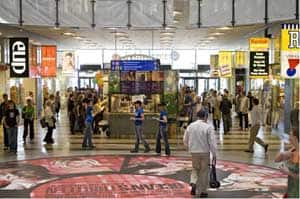 We ran a very successful ‘Good Deeds Taste Good’ campaign at our newly established Ben & Jerry’s scoop shop in December, 2007. We promised to give away €1 Euro for every pint sold from the scoop shop during the month, but we didn’t determine in advance what NGO would receive the donation. Rather, with each pint purchased, customers were given a chance to write down a suggestion for an organization that should receive the money. During the campaign, we sold 716 pints, a 30% increase above previous month, and thus raised €716 to donate. From all the good suggestions, we chose to donate this sum to an association that aims to help young people and their families in all kinds of life crisis, which has become a growing need in Finland in recent years. Of course, we also donated some ice cream to sweeten the deal!
We ran a very successful ‘Good Deeds Taste Good’ campaign at our newly established Ben & Jerry’s scoop shop in December, 2007. We promised to give away €1 Euro for every pint sold from the scoop shop during the month, but we didn’t determine in advance what NGO would receive the donation. Rather, with each pint purchased, customers were given a chance to write down a suggestion for an organization that should receive the money. During the campaign, we sold 716 pints, a 30% increase above previous month, and thus raised €716 to donate. From all the good suggestions, we chose to donate this sum to an association that aims to help young people and their families in all kinds of life crisis, which has become a growing need in Finland in recent years. Of course, we also donated some ice cream to sweeten the deal!
Portugal
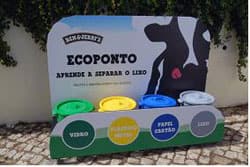 Portugal also hosted the Ben & Jerry’s 2007 Global Meeting, which gave us the opportunity to lead a hands-on service project with Ben & Jerry’s Brand Champions and other company leaders from around the world. We worked with a group called SOS Villages in Lisbon with a mission to provide a caring home environment for orphans. Our team spent a full day painting walls, redecorating a playing room, and playing with the children. At the end of the day, we all had smiles on our faces.
Portugal also hosted the Ben & Jerry’s 2007 Global Meeting, which gave us the opportunity to lead a hands-on service project with Ben & Jerry’s Brand Champions and other company leaders from around the world. We worked with a group called SOS Villages in Lisbon with a mission to provide a caring home environment for orphans. Our team spent a full day painting walls, redecorating a playing room, and playing with the children. At the end of the day, we all had smiles on our faces.
Singapore
For Free Cone Day 2007, participating Ben & Jerry’s shops in the city centre raised funds for Amazing Kidz, a nonprofit providing support to children with brain injuries.
We also used Free Cone Day to communicate our support for the Environmental Challenge Organisation (ECO) Singapore in the fight against global warming.